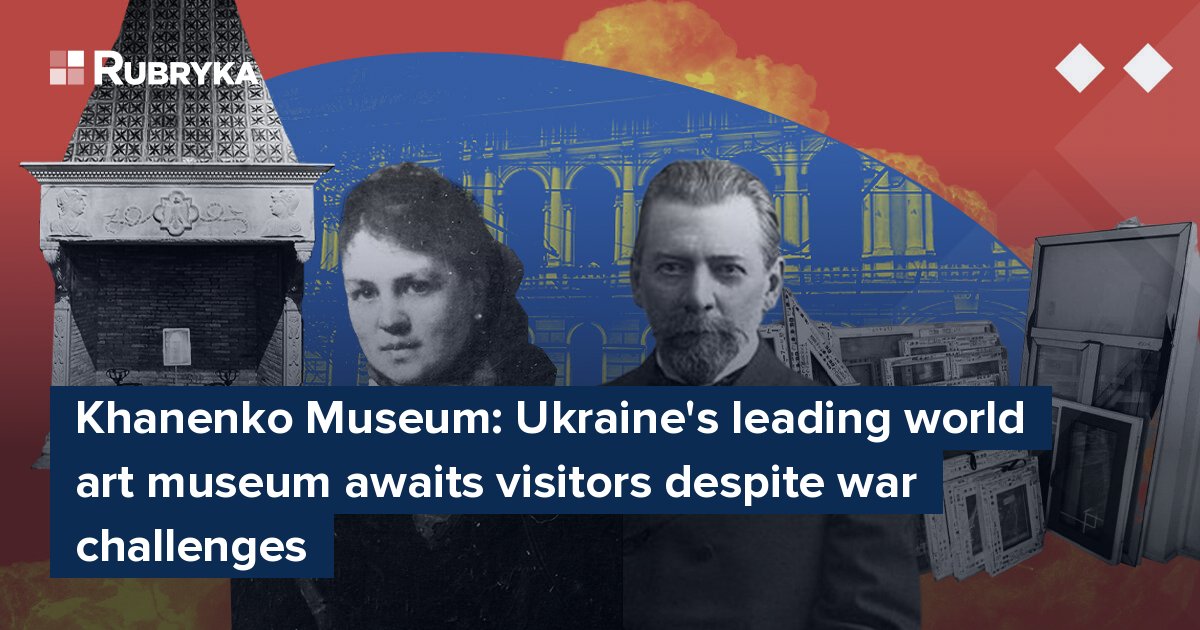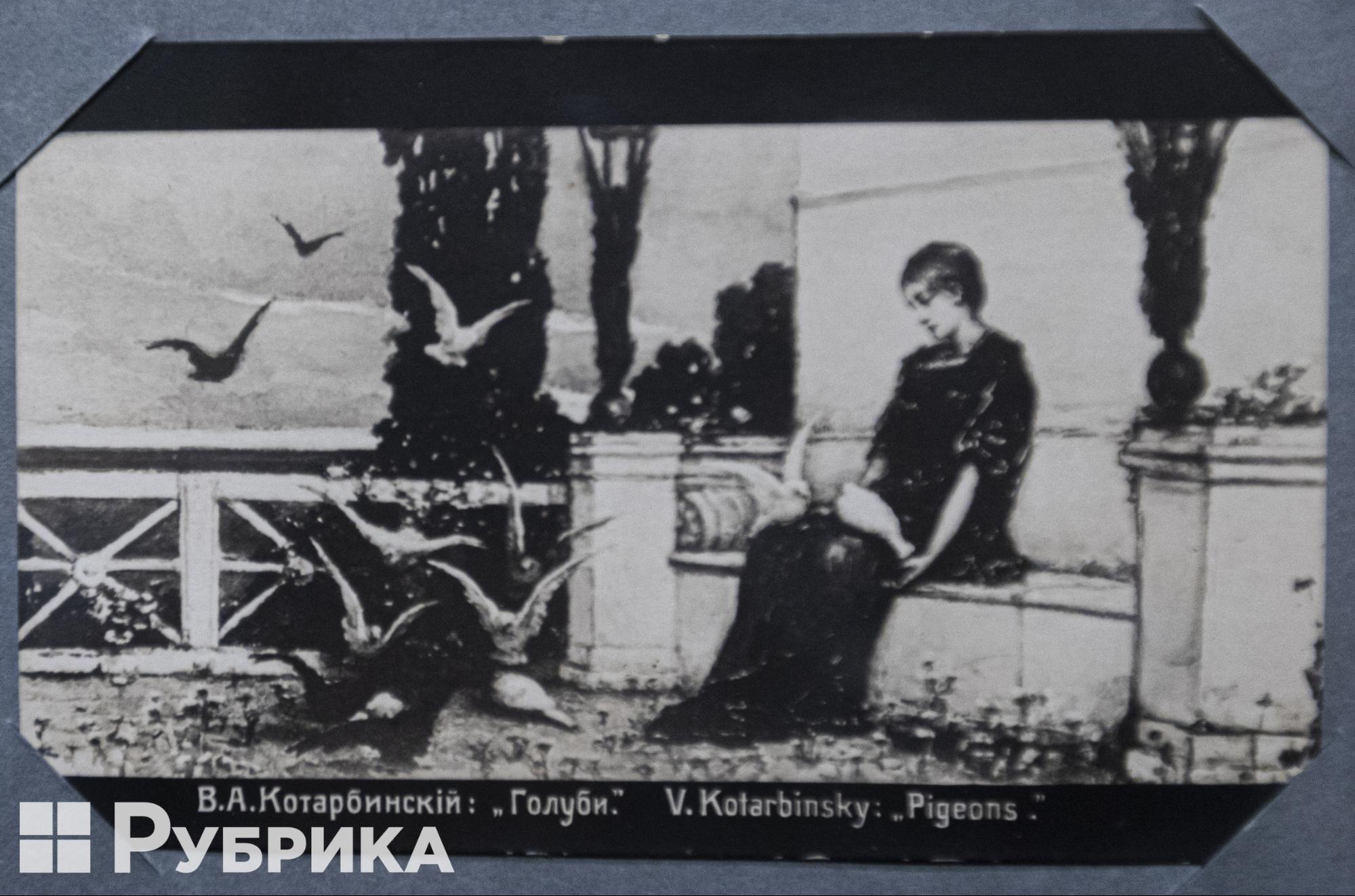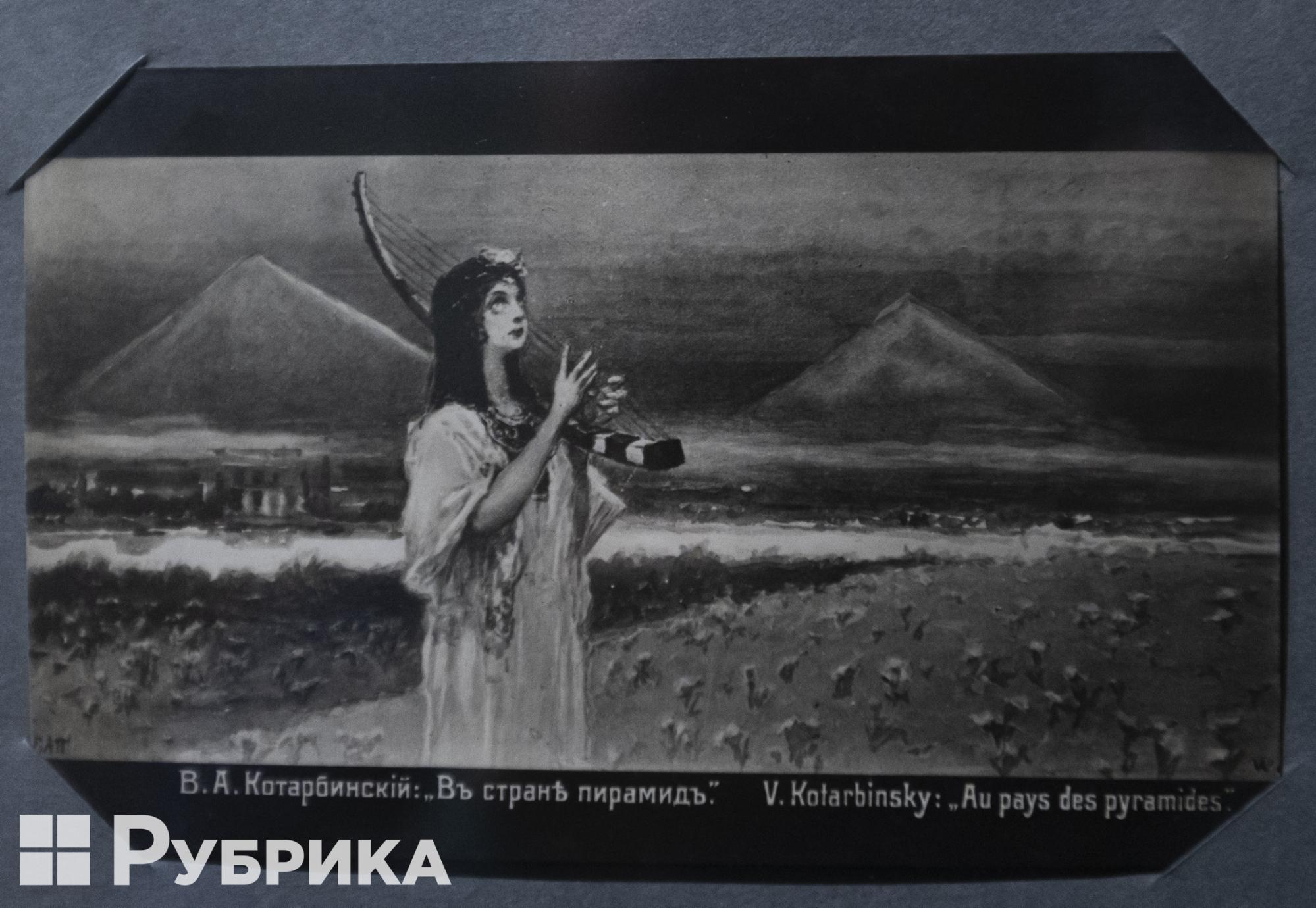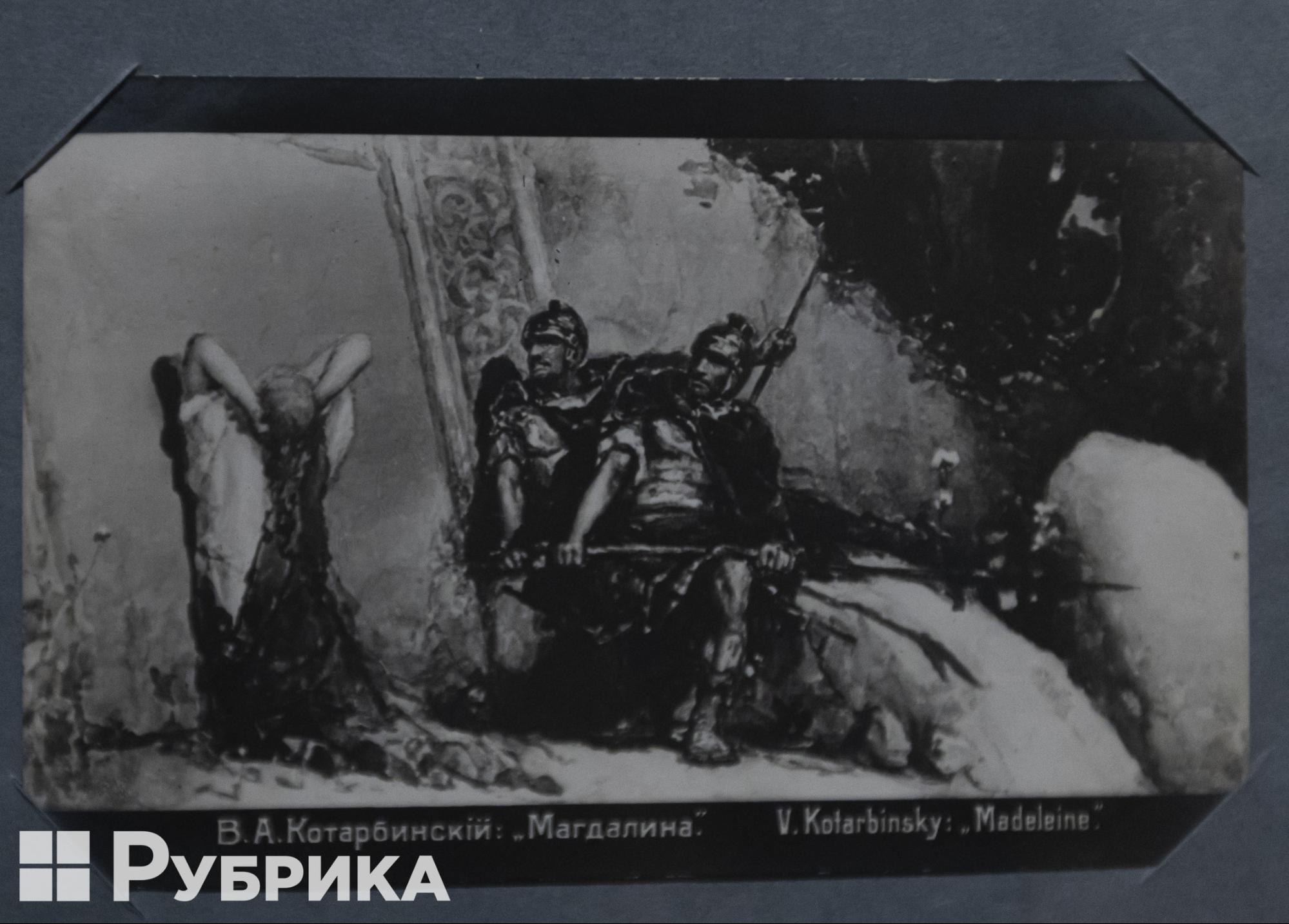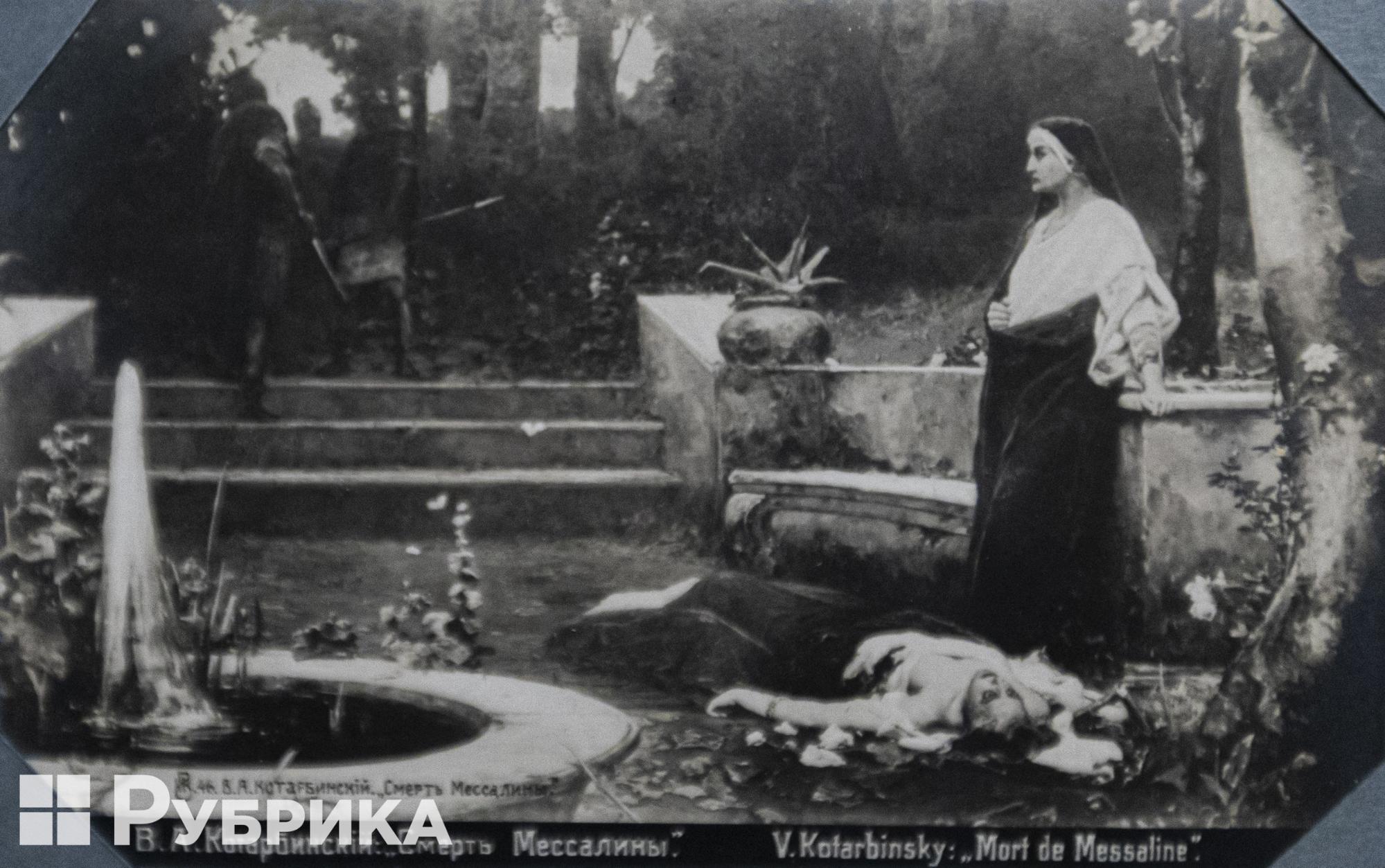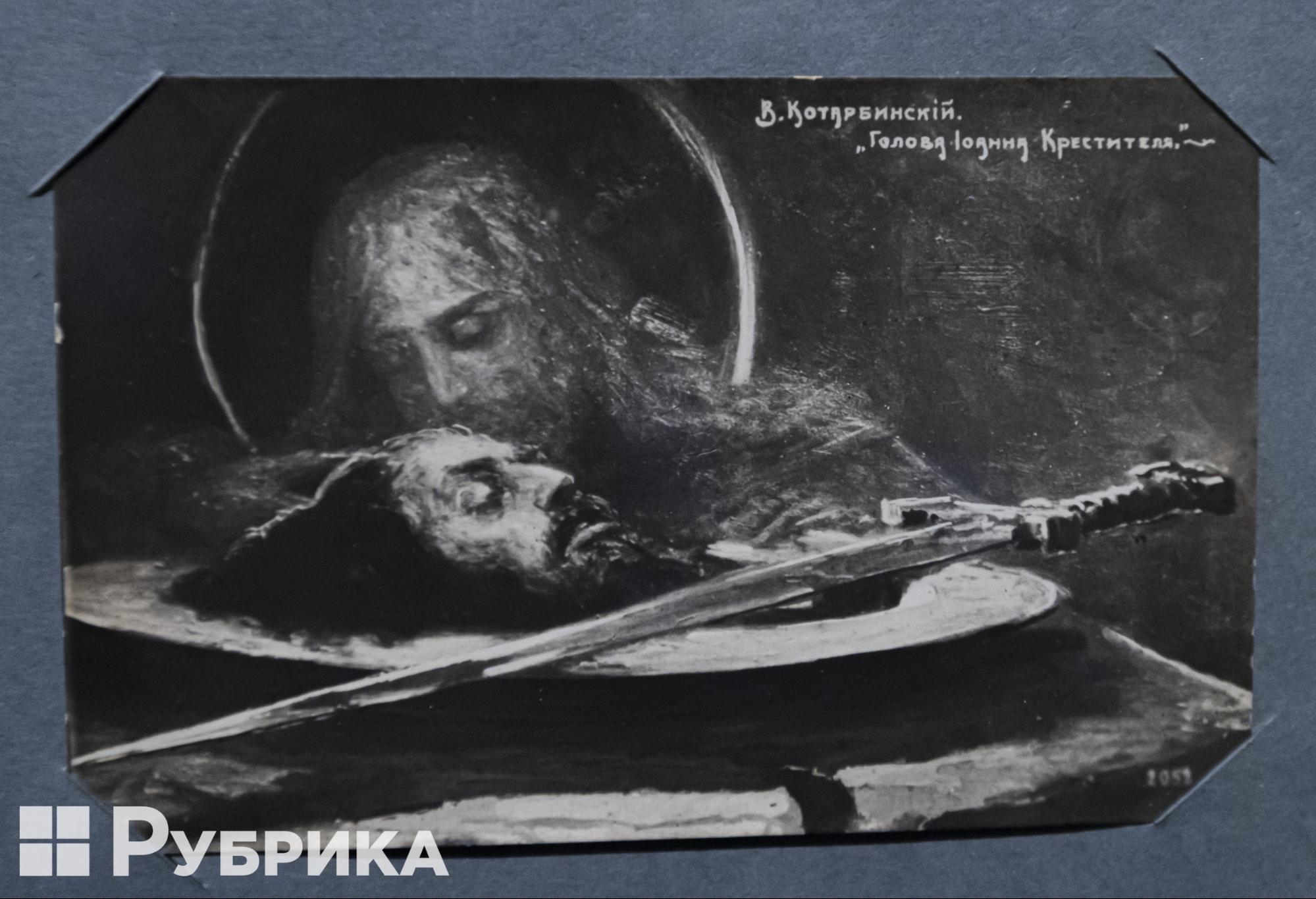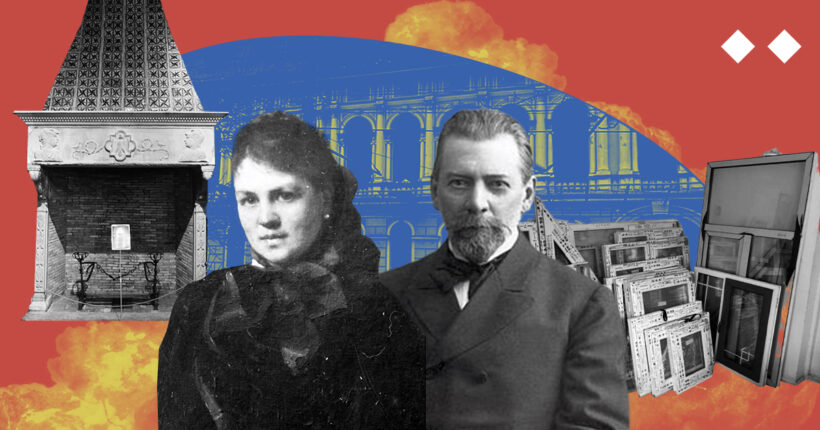
The Khanenko Museum is the leading museum of world art in Ukraine. The museum presents the most significant art collections of Europe, Asia and the Ancient World in Ukraine. The heart of the museum is the art collection of Bohdan and Varvara Khanenko — prominent Ukrainian collectors and philanthropists of the late 19th and early 20th centuries.
At the start of Russia's full-scale invasion, Khanenko's collection was dismantled and secured. Only the interior remains: walls with exquisite wallpaper, ceilings painted by painters, and a massive oak staircase. Thanks to the buildings' history and the workers' ingenuity, the Khanenko Museum works and awaits visitors.
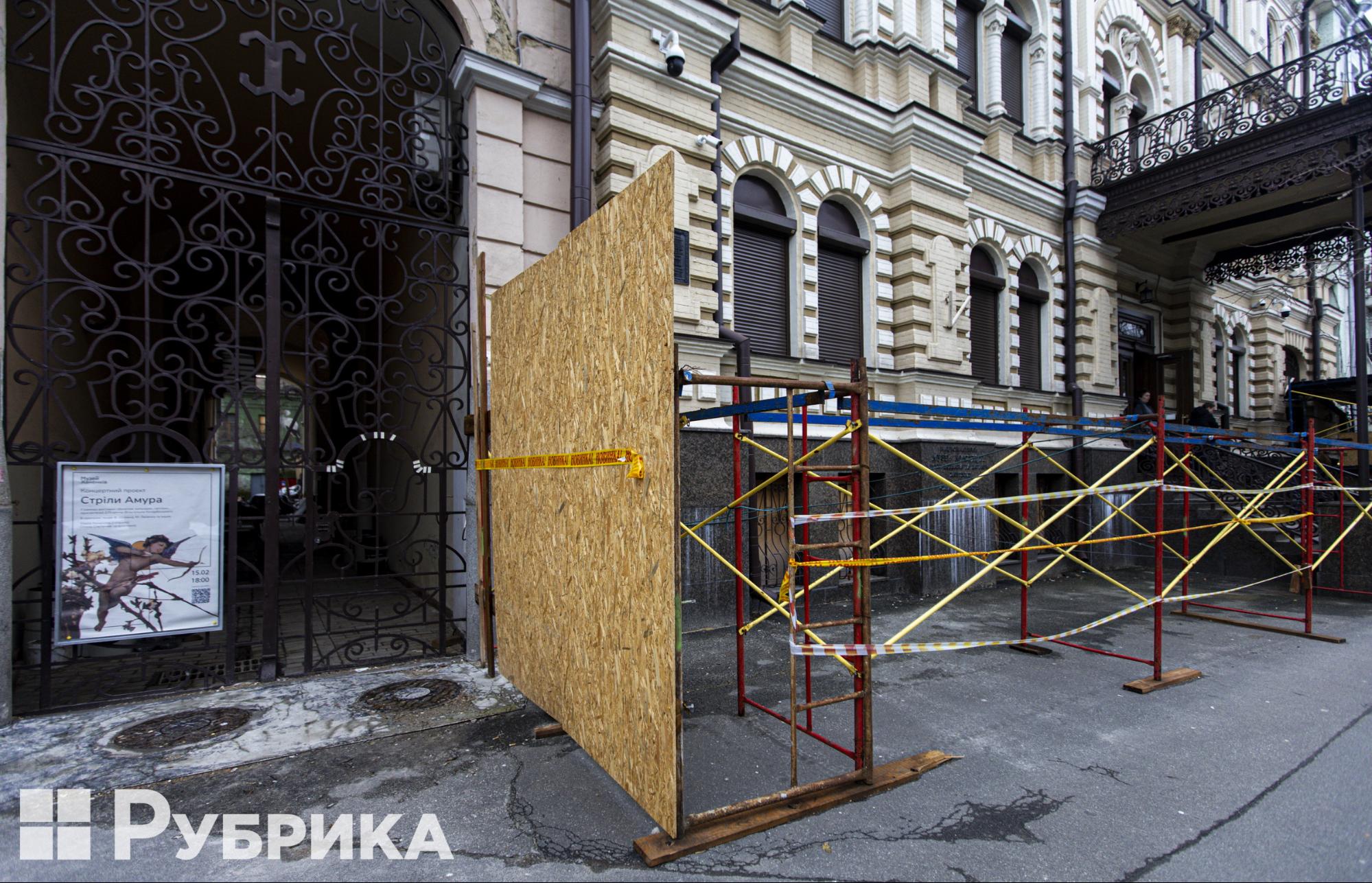
The facade of the Khanenko museum. Photo by Mykola Tymchenko
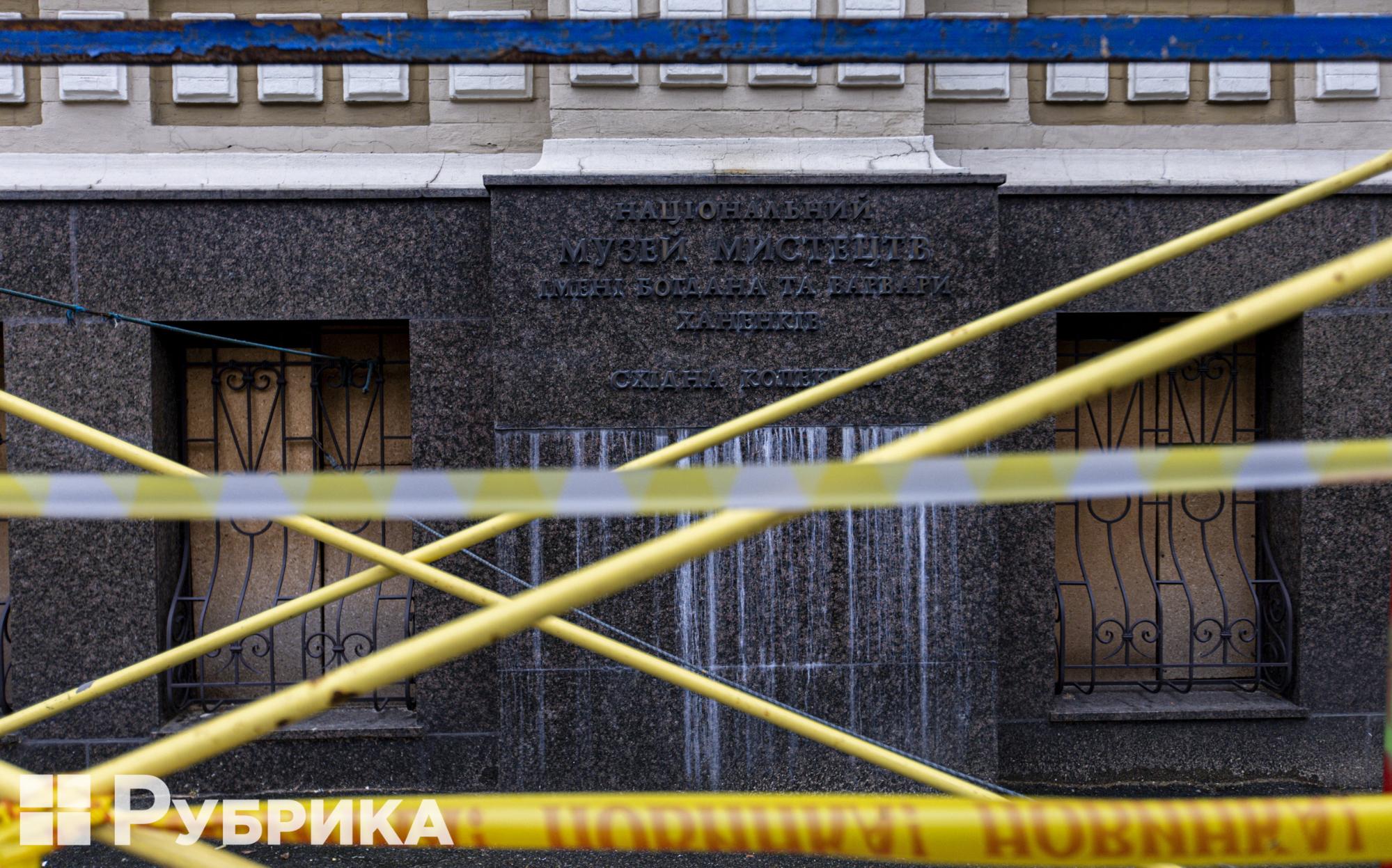
Windows covered with plywood, and the name of the museum on the facade. Photo by Mykola Tymchenko
What changed in the museum's work after the full-scale invasion
During World War II, the then employees of the Khanenko Museum did not have time to hide all the works of art from the German invaders. In 1943, before retreating, the invaders took some of the paintings by roughly cutting the canvases from the frames with a knife. This terrible picture was documented on camera. The museum workers remembered this case on the morning of February 24, 2022, when they hurried to hide the exhibits.
"We were so focused on the process that we didn't think about how it would be if the Russians entered. We worked until late in the evening," recalls Oleksandr Zhuk, head of the museum's educational department.
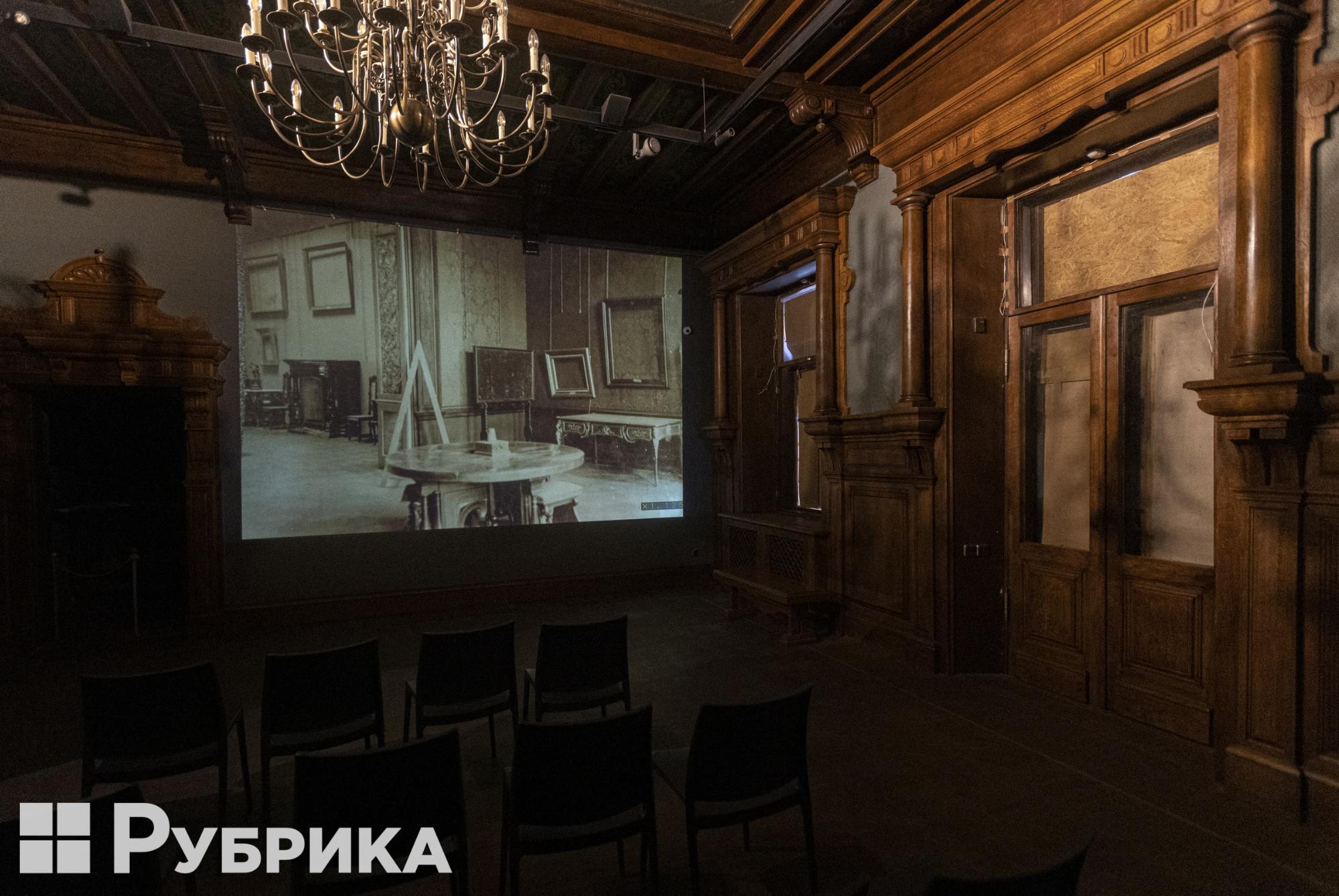
The spotlight shows a photo taken after the German occupation of the museum.
The Khanenko Museum was closed to visitors on the day Russia invaded Ukraine. Three months later, it was one of the first to resume work. In May 2022, employees conducted only street tours of the inner courtyard, telling the history of the Khanenko Museum. The first excursion, "Shadows and Walls," was held inside the building at the beginning of June. The museum's exhibits have been dismantled and secured, so the exposition was devoted to the interior and history of the buildings.
"When safety regulations allowed us to work with visitors, we began to think about the work format. Our colleagues Anastasiia Matselo and Olha Goncharenko created a whole story with elements of drama. Matselo played the piano and supplemented the tour with theatrical elements and productions," recalls Zhuk.
The museum was gradually restored. First, the exhibition "Soldiers" was held in one of the museum's buildings, and later, the second part of the museum was opened for the exhibition of works of modern Ukrainian artists "Meanwhile, in the Khanenko house." Various events, opera, lectures, and art exhibitions became part of the museum's work
How the museum was affected by the war
On October 10, 2022, a missile hit the playground in the capital's Shevchenko Park, directly opposite the museum. The museum was damaged — the windows were blown out, and cracks appeared in the beams of the main staircase and the beams that hold the roof.
"I arrived at the museum around 12 when the air raid alert was over. The picture was shocking — windows were blown out in all the houses along the street," recalls Zhuk.
The situation quickly gained publicity. A crowd gathered near the museum — people photographed the damage and offered help. Ukrainian and foreign reporters were waiting for comments.
Thanks to the help of volunteers and the perseverance of the museum staff, on the evening of October 10, all the damaged windows were covered with plywood. Soon, the museum resumed its work, and even during the renovation, tours continued.
"We had a choice — either we close the museum for repairs and go on vacation at our own expense, or we look for a compromise between construction needs and our activities. We decided to balance. During these three months, we held a huge number of events and received a lot of visitors," Zhuk shared with Rubryka.
The journey begins at the house of the Sakhnovsky
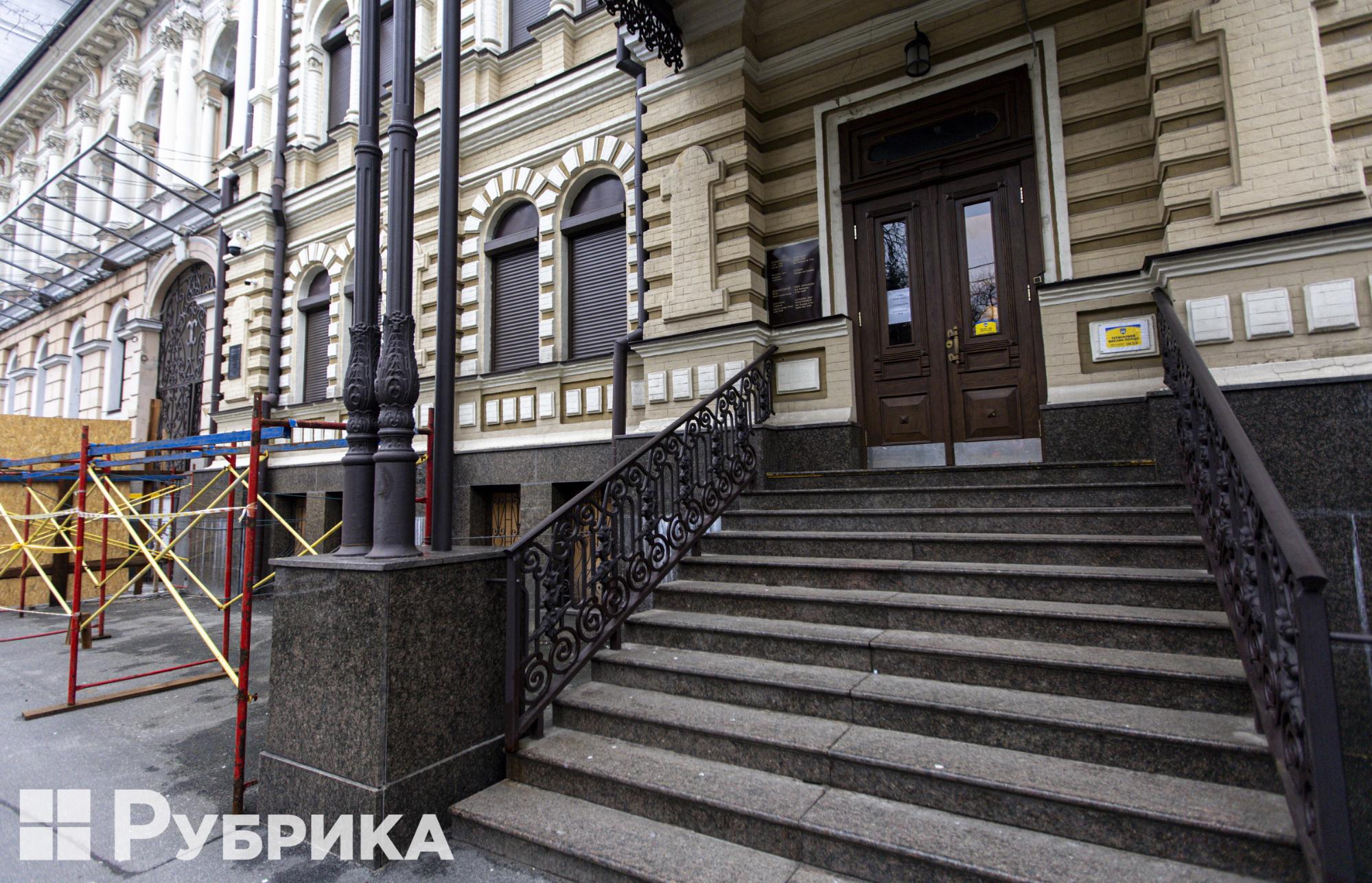
Stairs in front of the museum. Photo by Mykola Tymchenko
Rubryka visited the museum during the "Gold, Color, Light" exhibition. Together with the head of the museum's educational department, we go up to the second floor of building 17. This is where our journey through the history of the museum begins — from the life of the Khanenko couple, who founded the museum in the 20th century, to the full-scale invasion of Russia into Ukraine today.
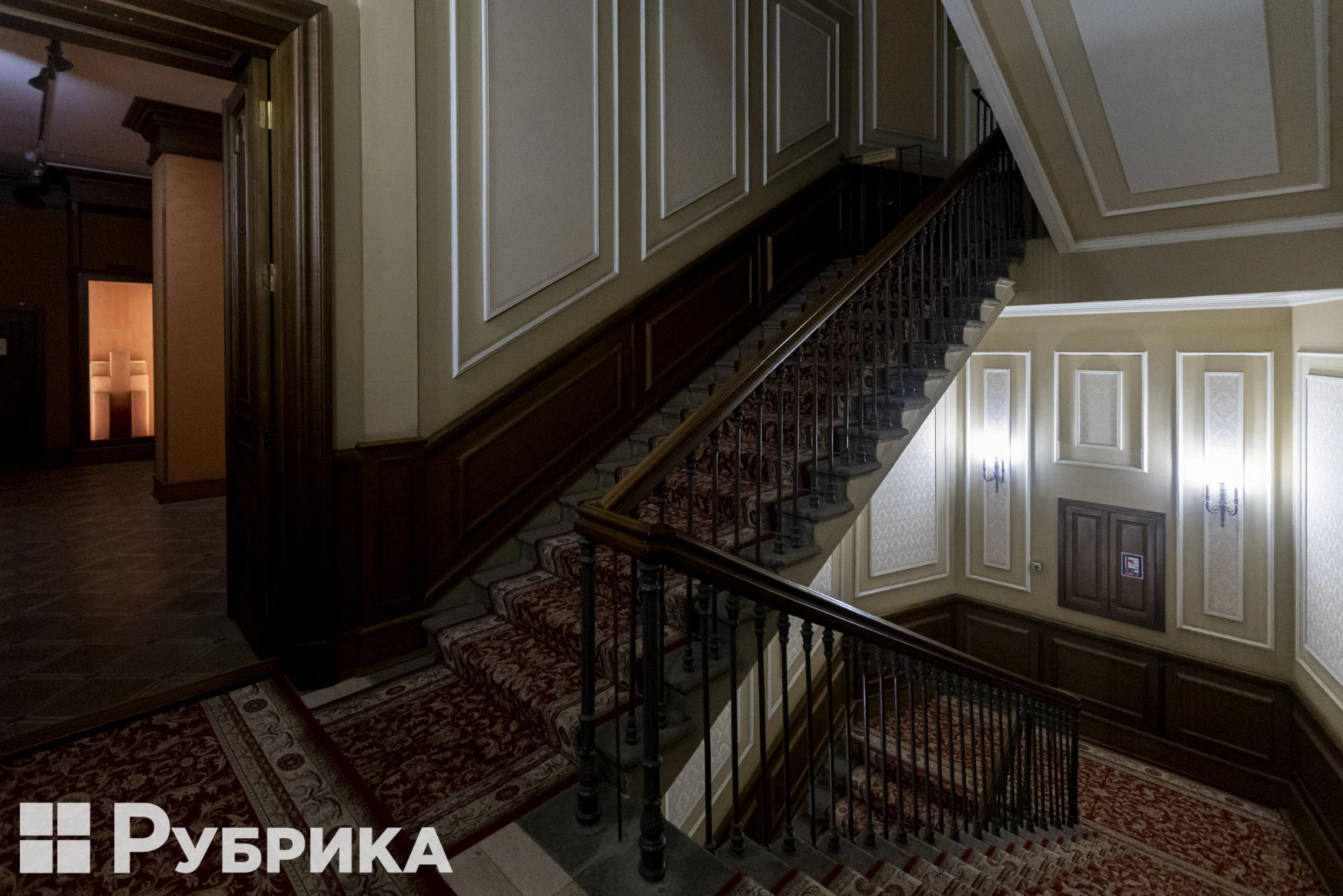
The stairs of the Sakhnovsky house.
The Khanenko Museum is an ensemble of two connected buildings, 15 and 17. In the 19th century, they were bought by the influential Ukrainian entrepreneur and philanthropist Nikolas Tereshchenko. He gave house 15 to his eldest daughter, Varvara, who married a successful lawyer, Bohdan Khanenko, and number 17 to his youngest daughter, Efrosinia, who married Sakhnovsky.
Bohdan and Varvara lived in building 15 all their lives, so the third floor is private. It is impossible to get to it because employees have been protecting the personal history of the spouses for decades. The museum collection was always exhibited in the front part of the house, both during the life of the Khanenkos and after their death. However, in 1987, changes occurred — building 17 was also transferred to the museum. After restoration and repair, since 2006, the best works of the Asian collection have been presented in the Sakhnovsky house and the European ones in the Khanenko house.
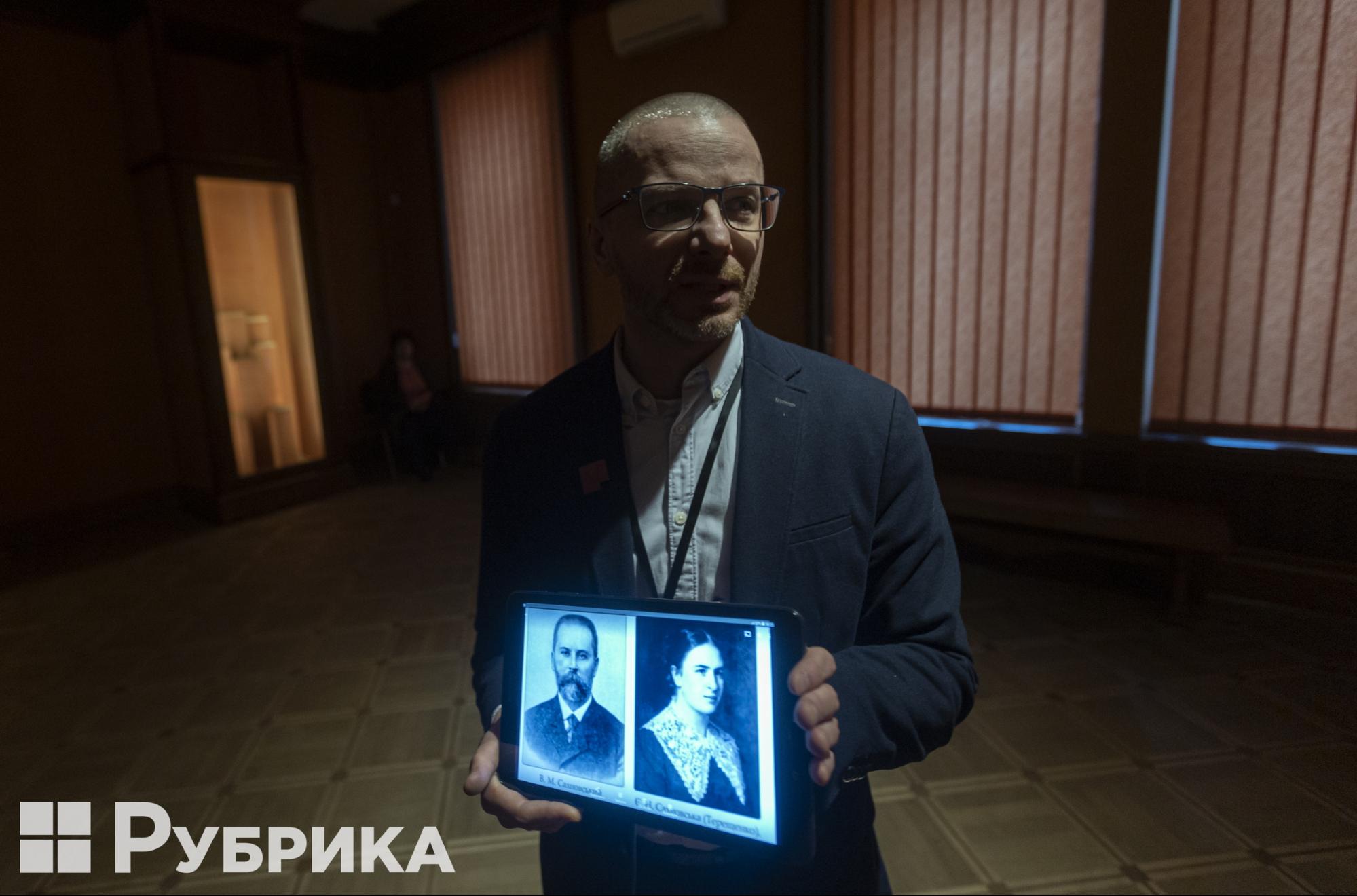
Oleksandr Zhuk tells about the history of the Sakhnovsky house.
From 2006 until the full-scale war, guests enjoyed the art of China, Japan, Buddhism, and Islam in these halls. Now, only empty walls and empty glass windows with yellow, red, or orange backlight can be seen.
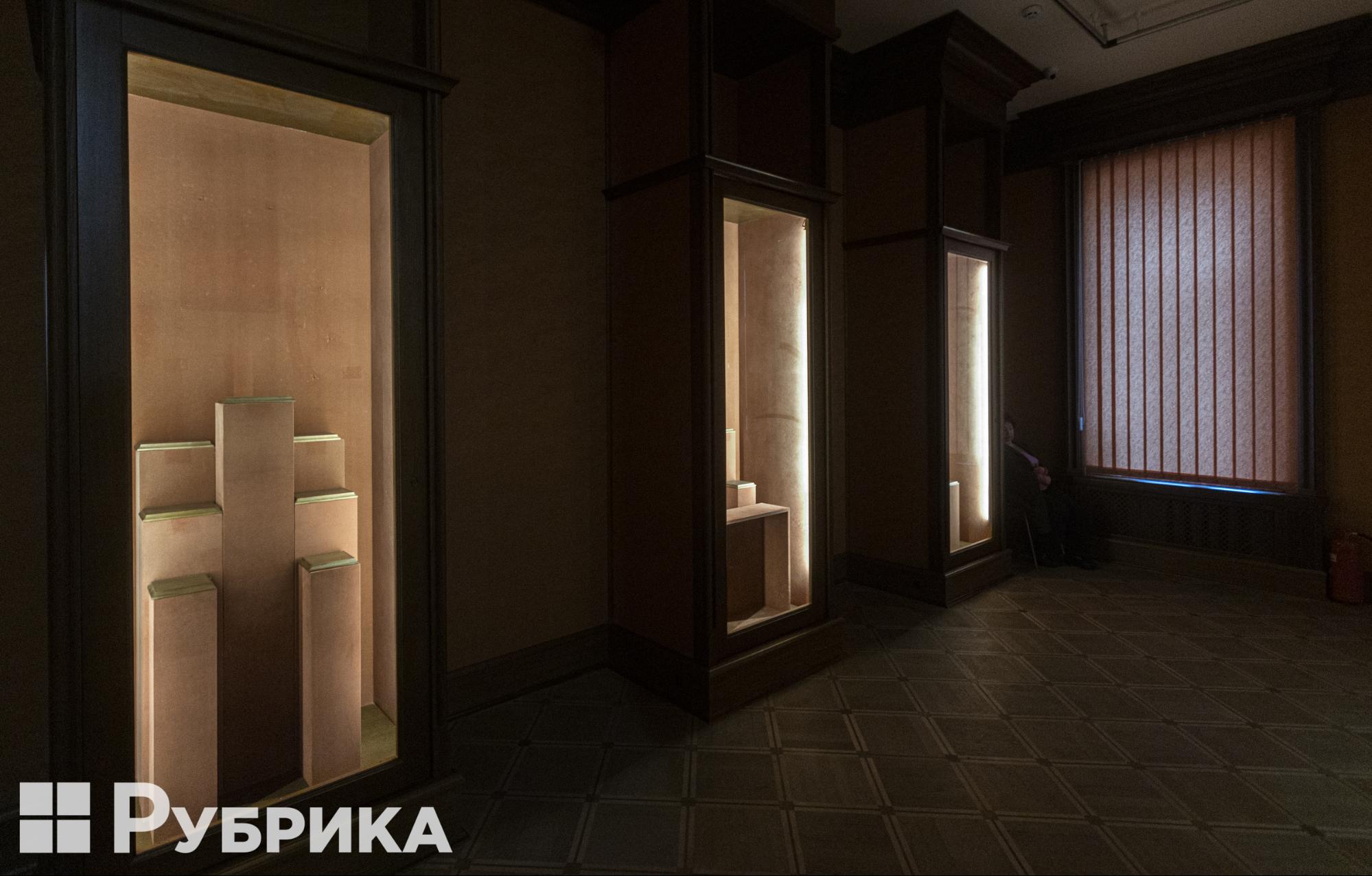
Empty displays in building 17.
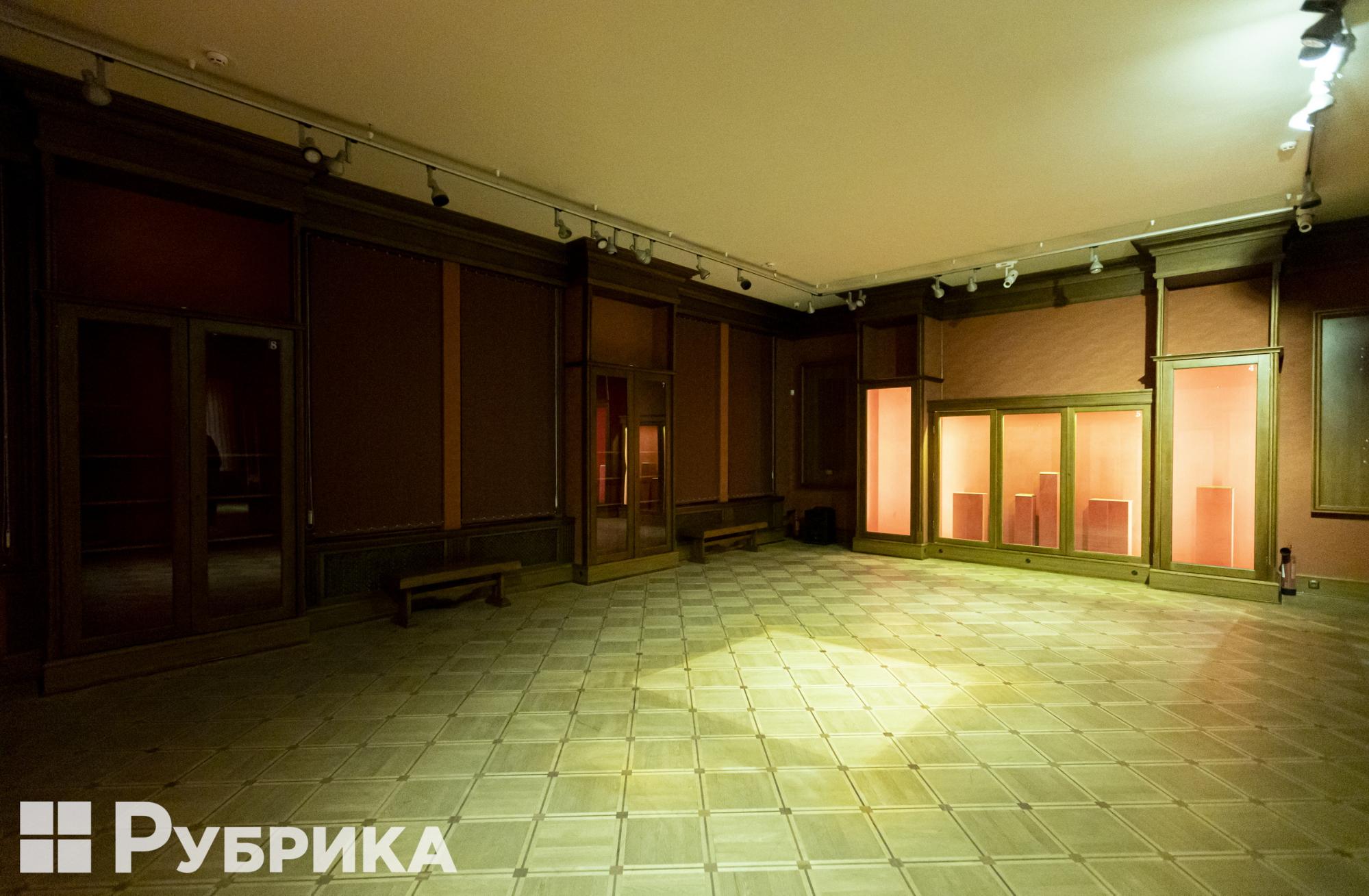
The empty hall of the Sakhnovsky house.
It is semi-dark, and the windows are closed. Even though it is daytime outside, the sun does not penetrate inside. There are no visitors here; only the museum employees who monitor order remain. However, they are almost invisible in the darkened corners of the hall.
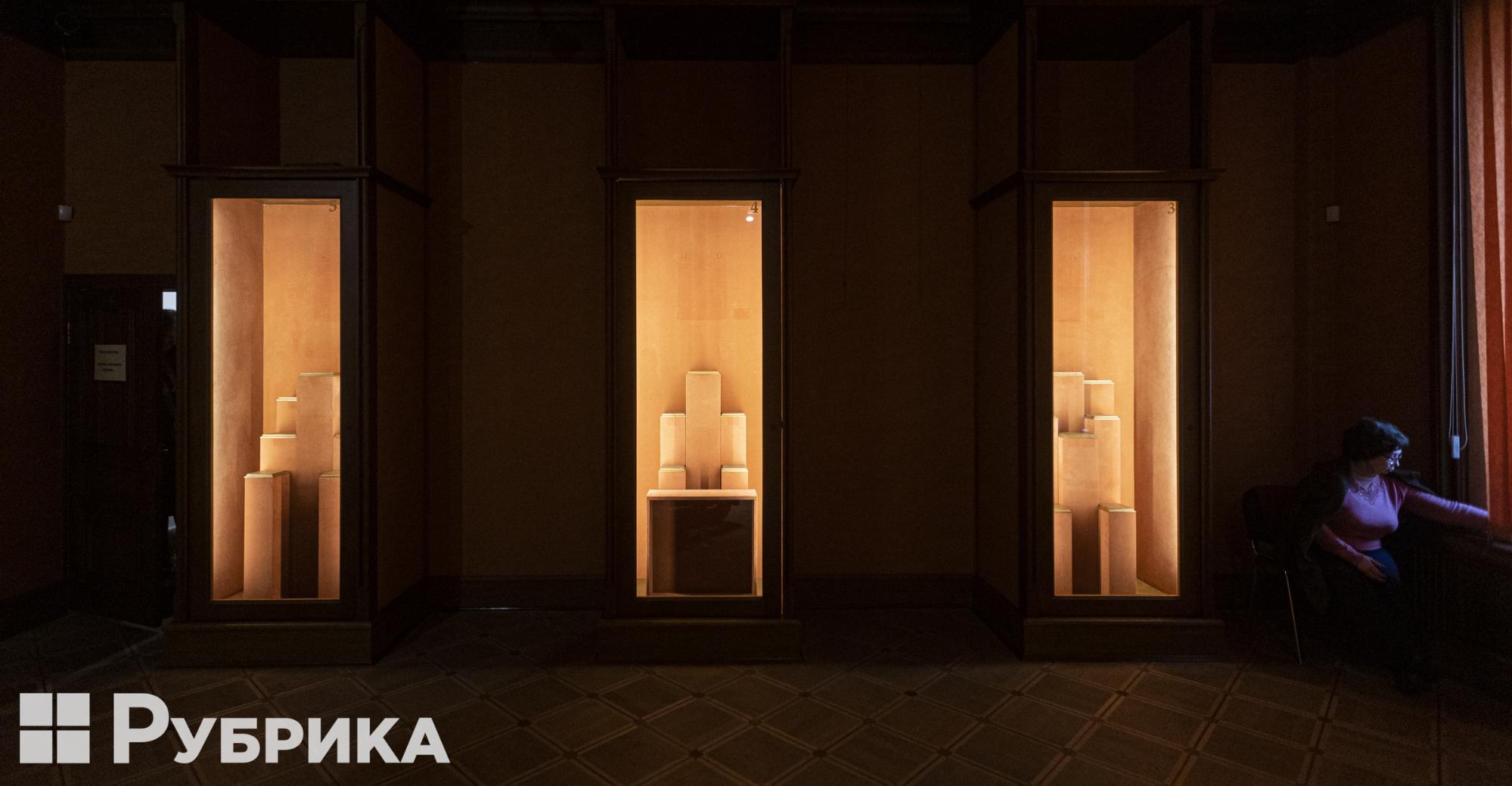
The main source of light in the Asian part is spotlights and lighting in displays.
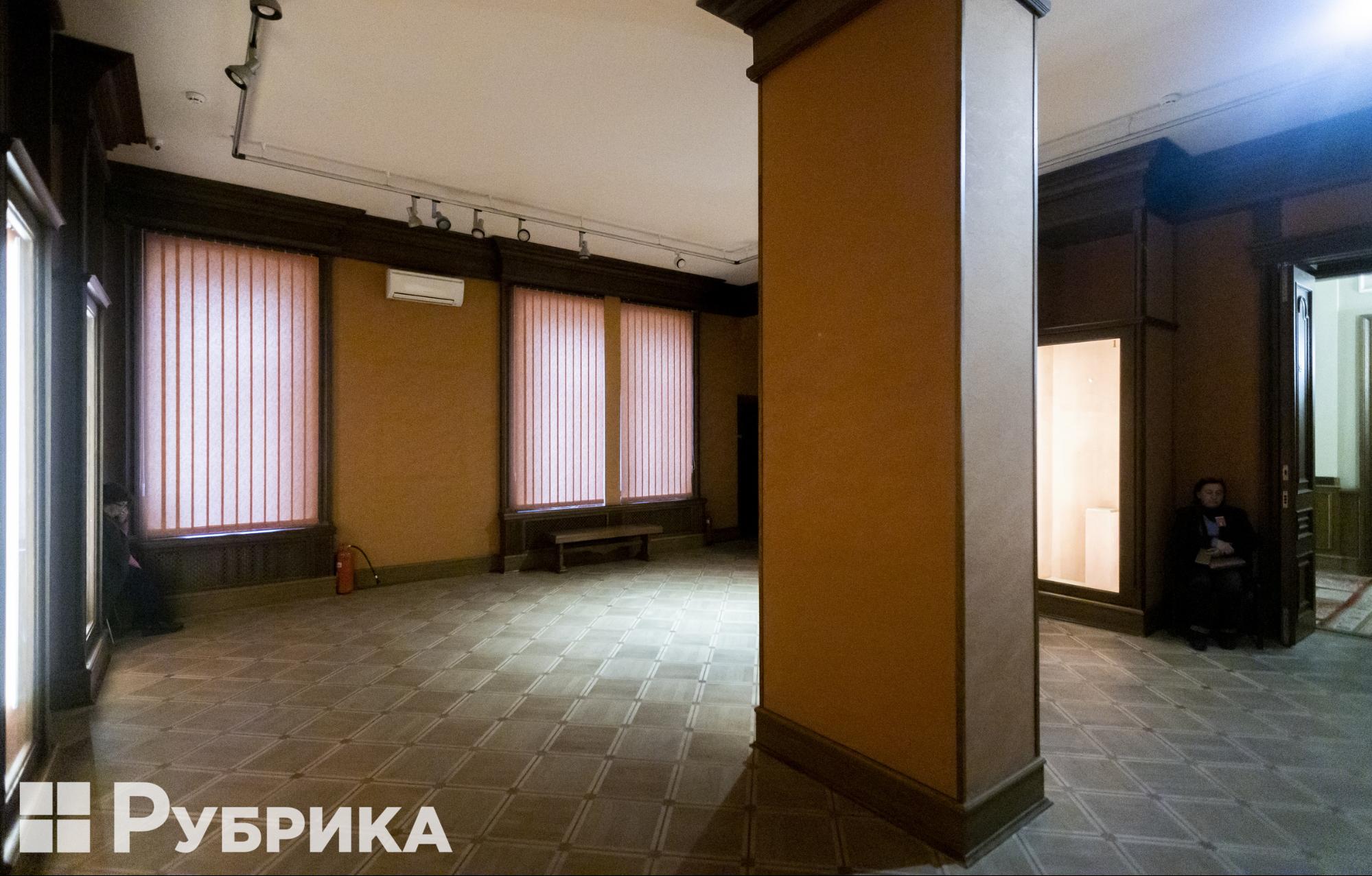
Asian part of the museum.
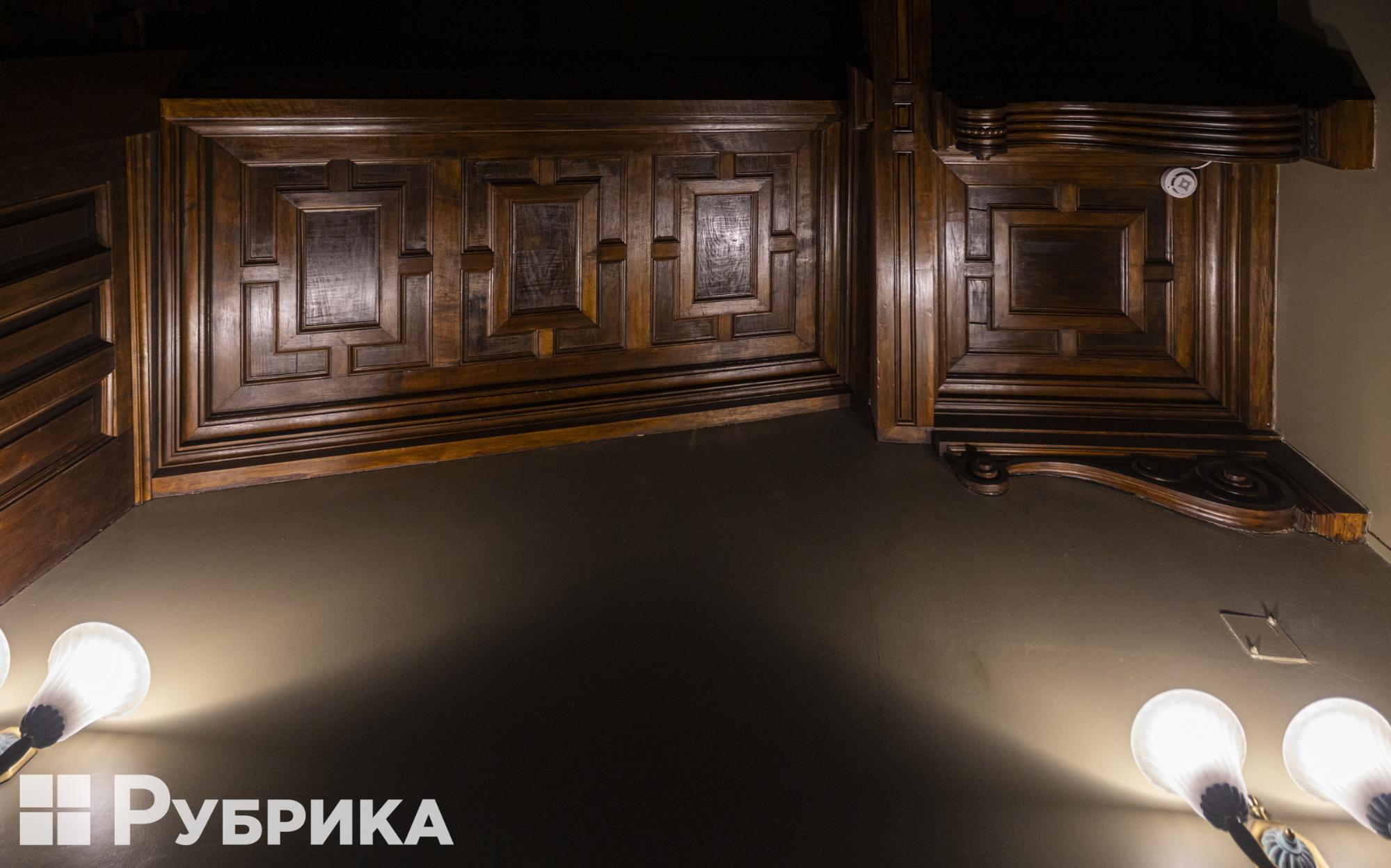
Bottom view of the oak stairs.
Khanenko Palace
A narrow passage leads to building 15. Once in the Khanenko house, we see a large oak staircase leading to the third floor. The Khanenko house appears to be two floors from the facade. The third mezzanine floor of the building can be seen only from the inner courtyard. It was built for the couple's private apartments. There is a dressing room, a bathroom, Varvara's office, and Dunyasha's room, where she accompanied Mrs. Khanenko all her life.
The house is a classic example of urban palace architecture, limited in space.
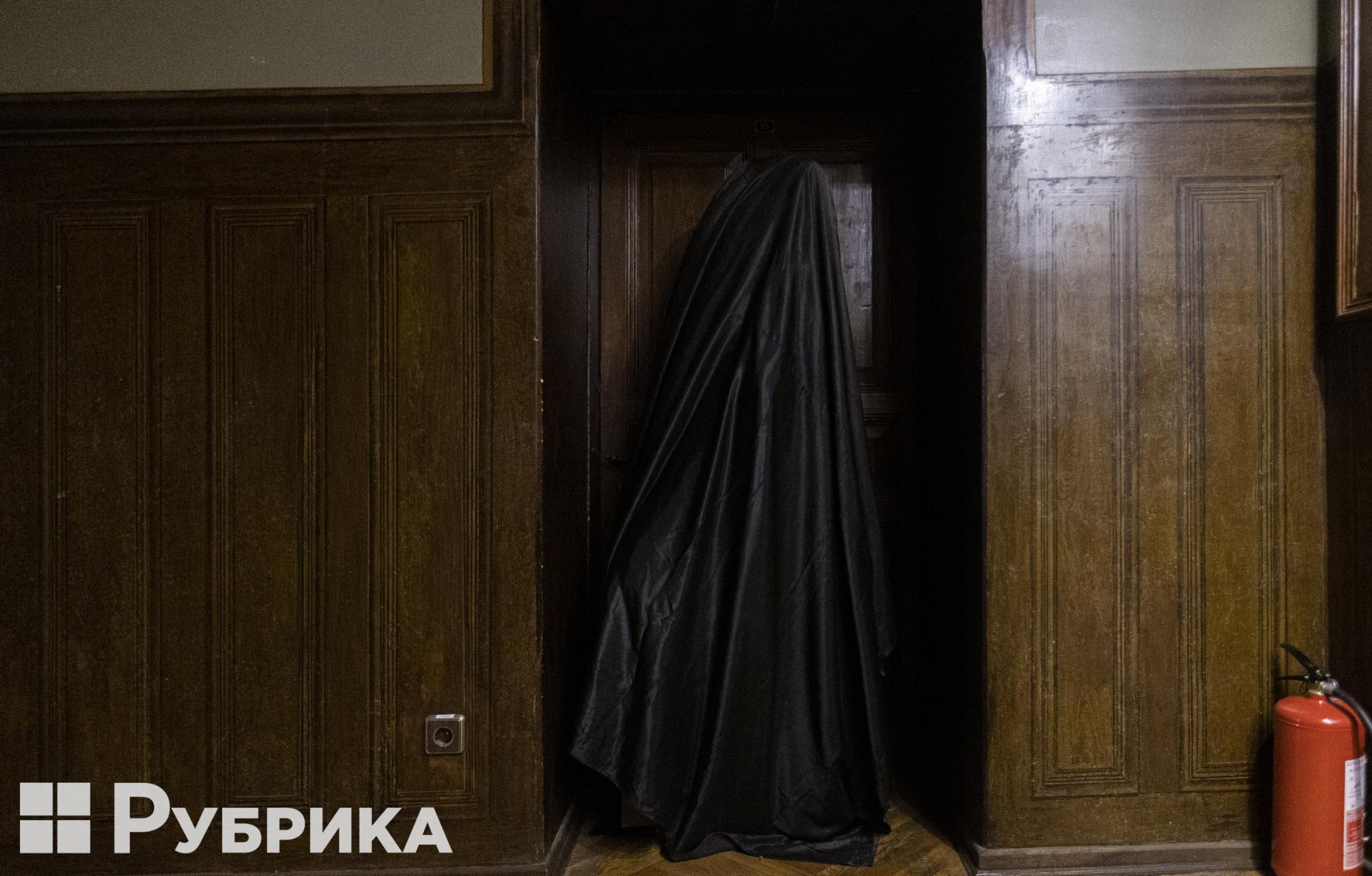
The doors leading to the Golden Study are closed. You can quickly get through them from the living room to the main room.
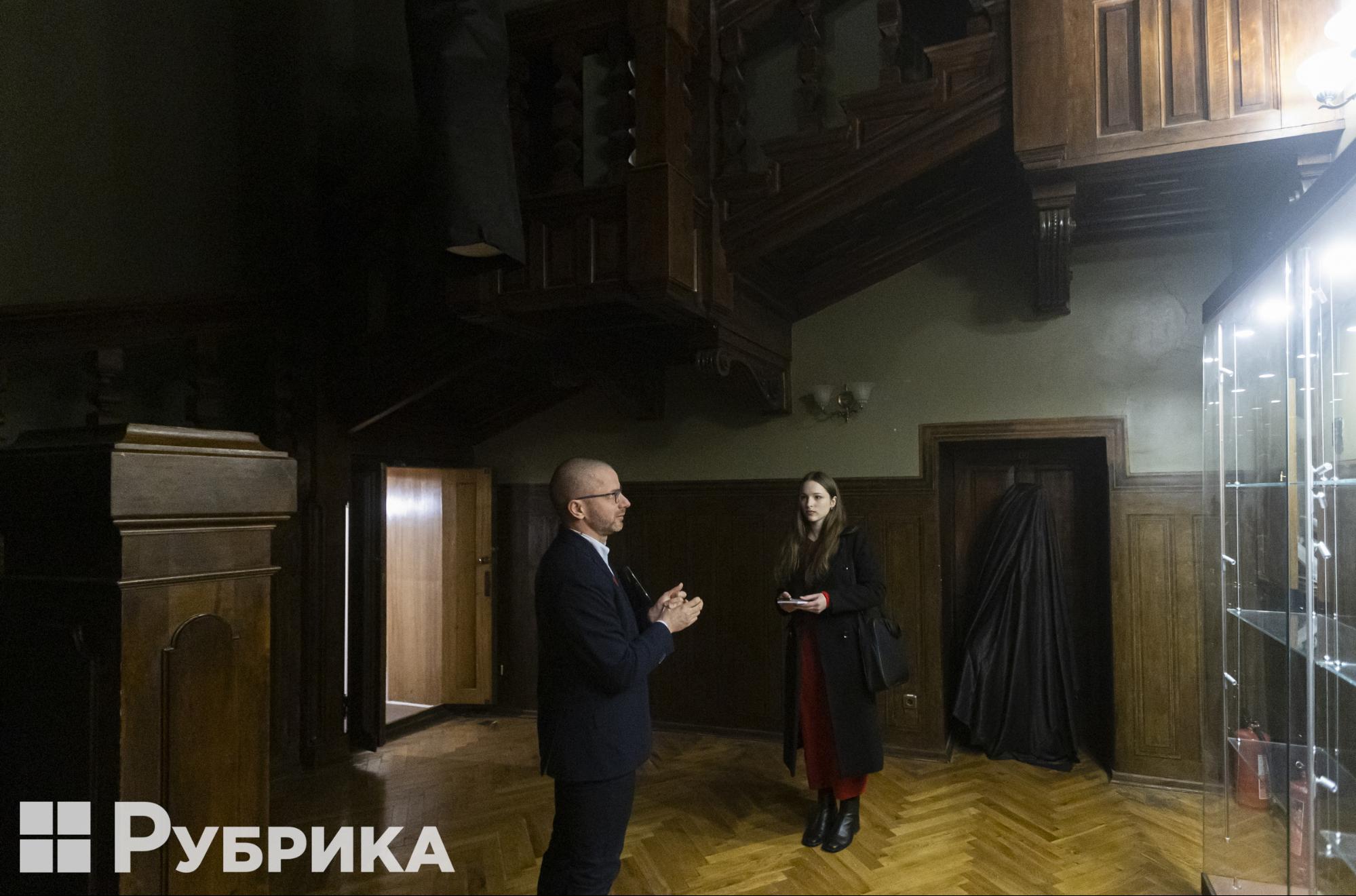
Oleksandr Zhuk tells the story of the Khanenko Palace.
The small room is illuminated by semi-dimmed lampshades that look like flowers. In the Khanenko Palace, the air is saturated with the smells of a house with history, old wooden furniture, and walls. Despite this, it is easy to breathe, and it is fresh here. Together with the tour guide, we move to the next hall to the creaking accompaniment of floorboards.
Bohdan's workspace or Karelian birch office
We find ourselves in a spacious room. During the life of the Khanenkos, it served as Bohdan's office. According to the workers, the original furniture was made of Karelian birch. However, only the window frames made of dark oak, decorated with exquisite carvings, have survived to this day. According to Zhuk, they can be opened easily because the mechanism works properly.
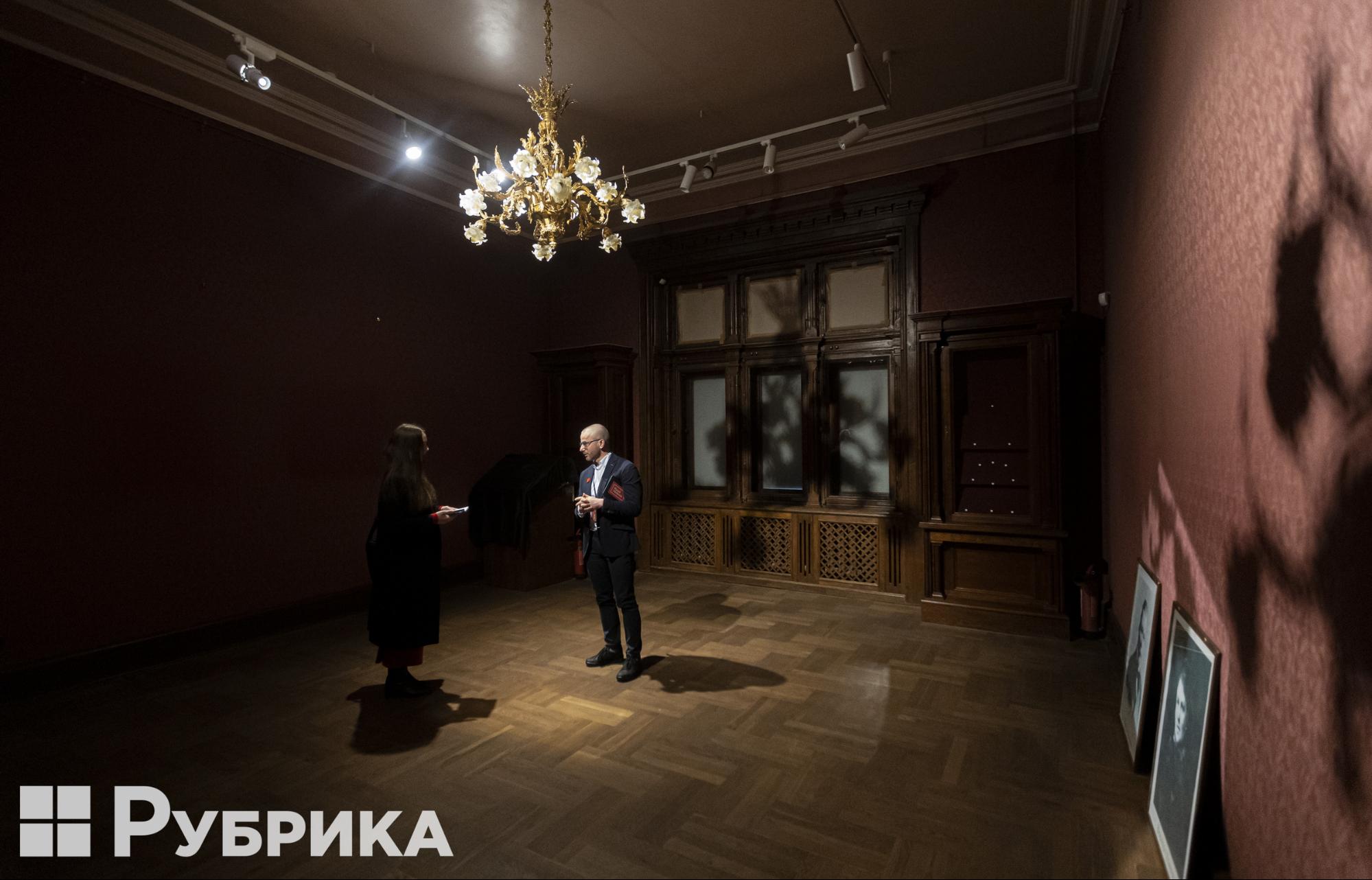
Karelian birch study.
The employees who managed the museum after Varvara's death in 1922 did not care about its founders' history. They removed the names of the Khanenkos from the name of the museum due to "Khanenko's lack of revolutionary merits to proletarian culture." And they did not consider it necessary to preserve the original interiors of the house. The real name of the museum was returned after Ukraine regained its independence and reopened the museum in 1998.
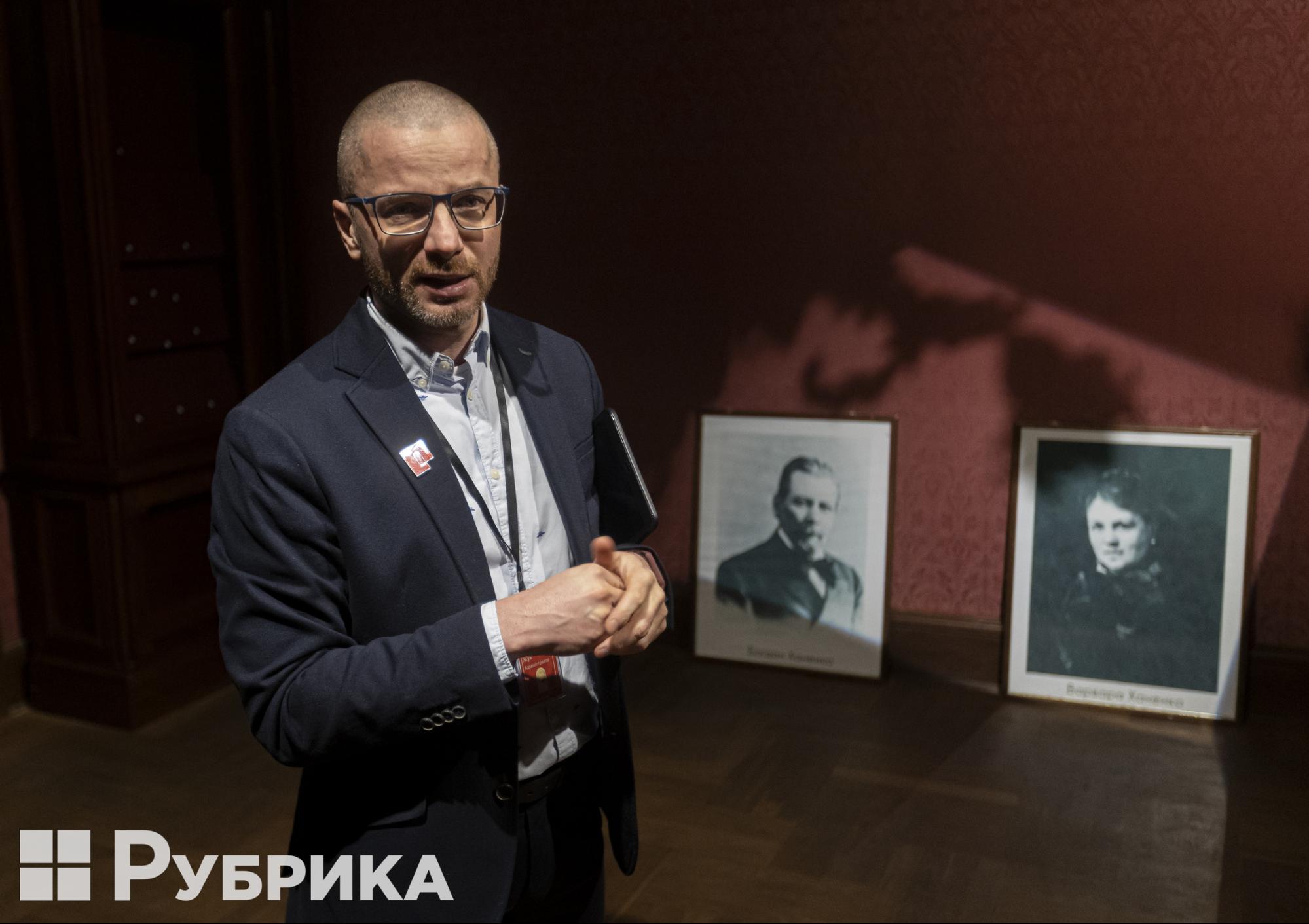
Oleksandr Zhuk tells about the interior of the Karelian birch office.
"None of us considered why no facade frame has been opened like this for 30 years. After the windows flew out, it turned out that they were frames of the 60s of the XX century, made of pine. The Khanenkos simply could not make the windows of the front part of the house from this wood. They made them only from oak, so this is the only original window," explains Zhuk.
On the floor are portraits of Bohdan and Varvara Khanenko. Previously, paintings of the house owners stood on easels in front of the grand staircase. Museum workers considered it inappropriate to hang them on the wall in the museum without exposure. Therefore, Mr. and Mrs. Khanenko look at the visitors through the glass frame, leaning against the wall of Bohdan's office.
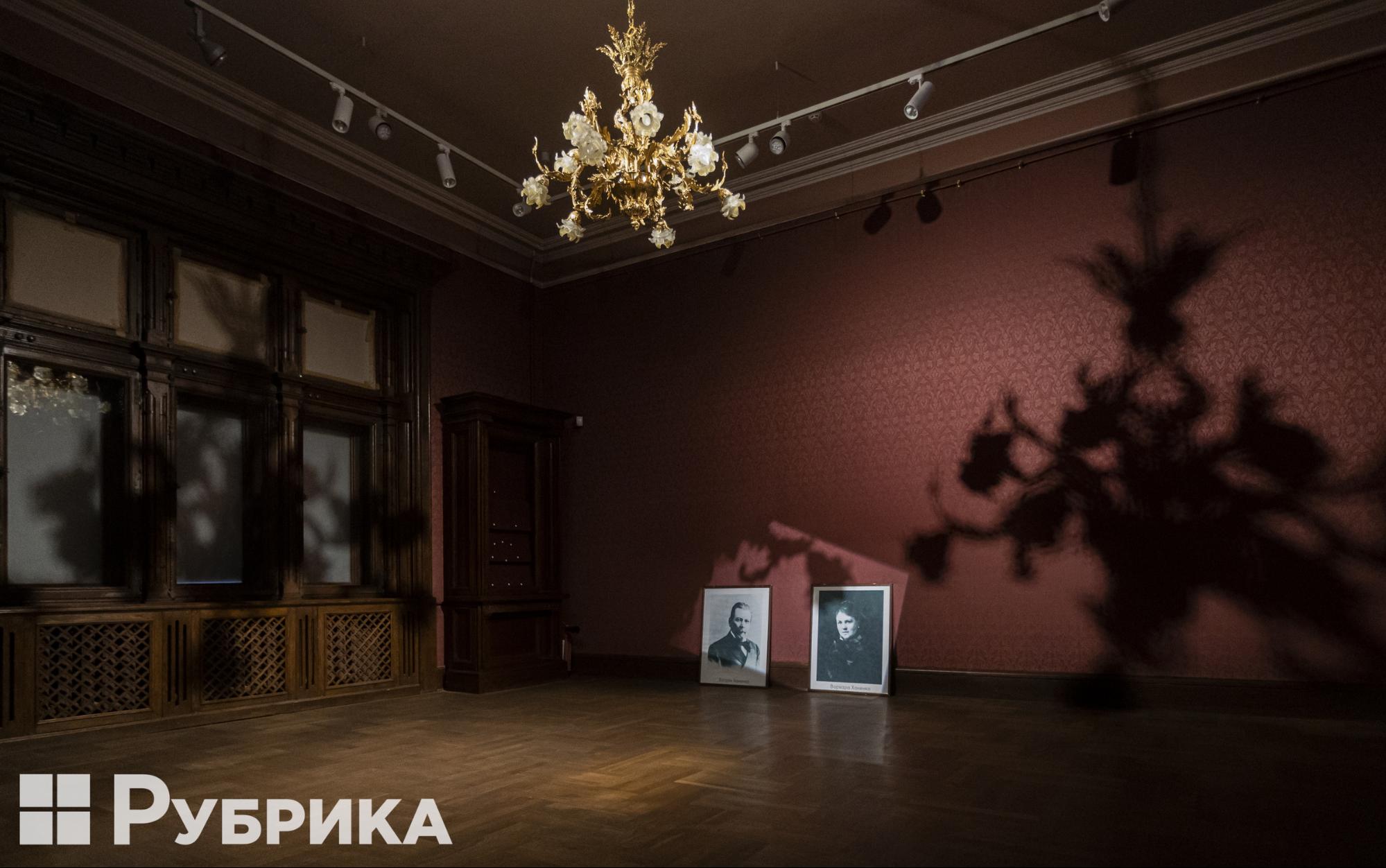
Photo by Mykola Tymchenko.
Dutch Delft dining room
The next room is the couple's dining room. Instead of exquisite stained-glass windows of the 17th century, the windows have plywood that does not allow light to pass through. Now, the main light source is a spotlight that projects an image onto one of the walls. During the excursion, the museum staff, in this way, shows visitors archival photos related to the history of the Khanenko Museum.
Most of the room is occupied by office chairs, on which guests listen to a short lecture about the house's history. If they look up, they will see a painted ceiling. Mythical creatures are depicted on a blue background: golden dragons, griffins, and eagles. In the center, above the chandelier, there is the Khanenko family coat of arms and a knight's helmet with scattered feathers. The grandeur of the ceiling is particularly impressive now, as it is the only canvas that cannot be dismantled, so it remains in the museum.
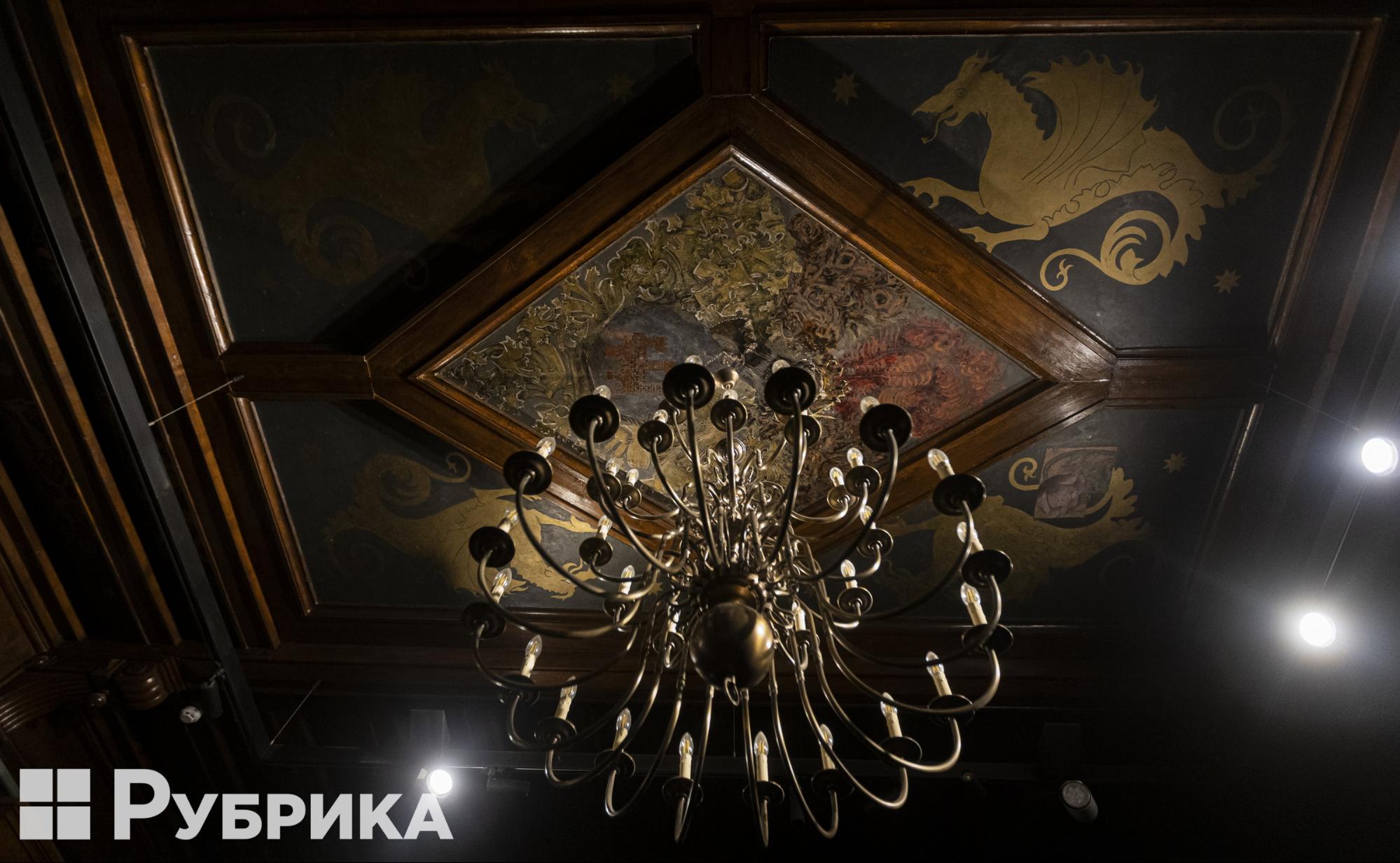
Pained ceiling.
Gallery
We pass from the private part of the building to the front. The gallery has much more space, as the ceiling is higher than in the previous rooms. This hall is decorated in the neoclassical style. There are not many decorative elements, only brackets with a delicate carving. They serve as a support for the balcony.
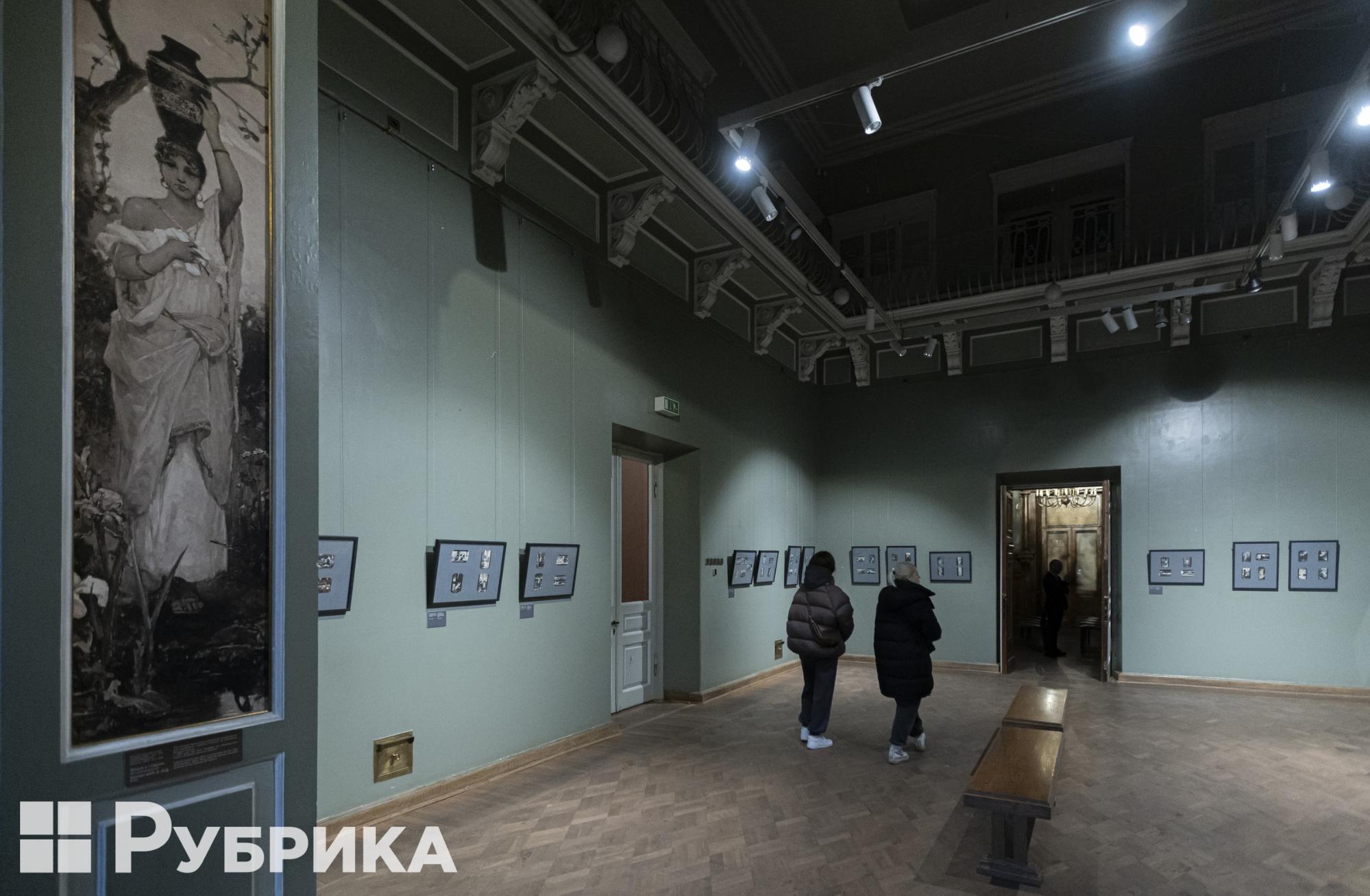
Gallery. Photo by Mykola Tymchenko
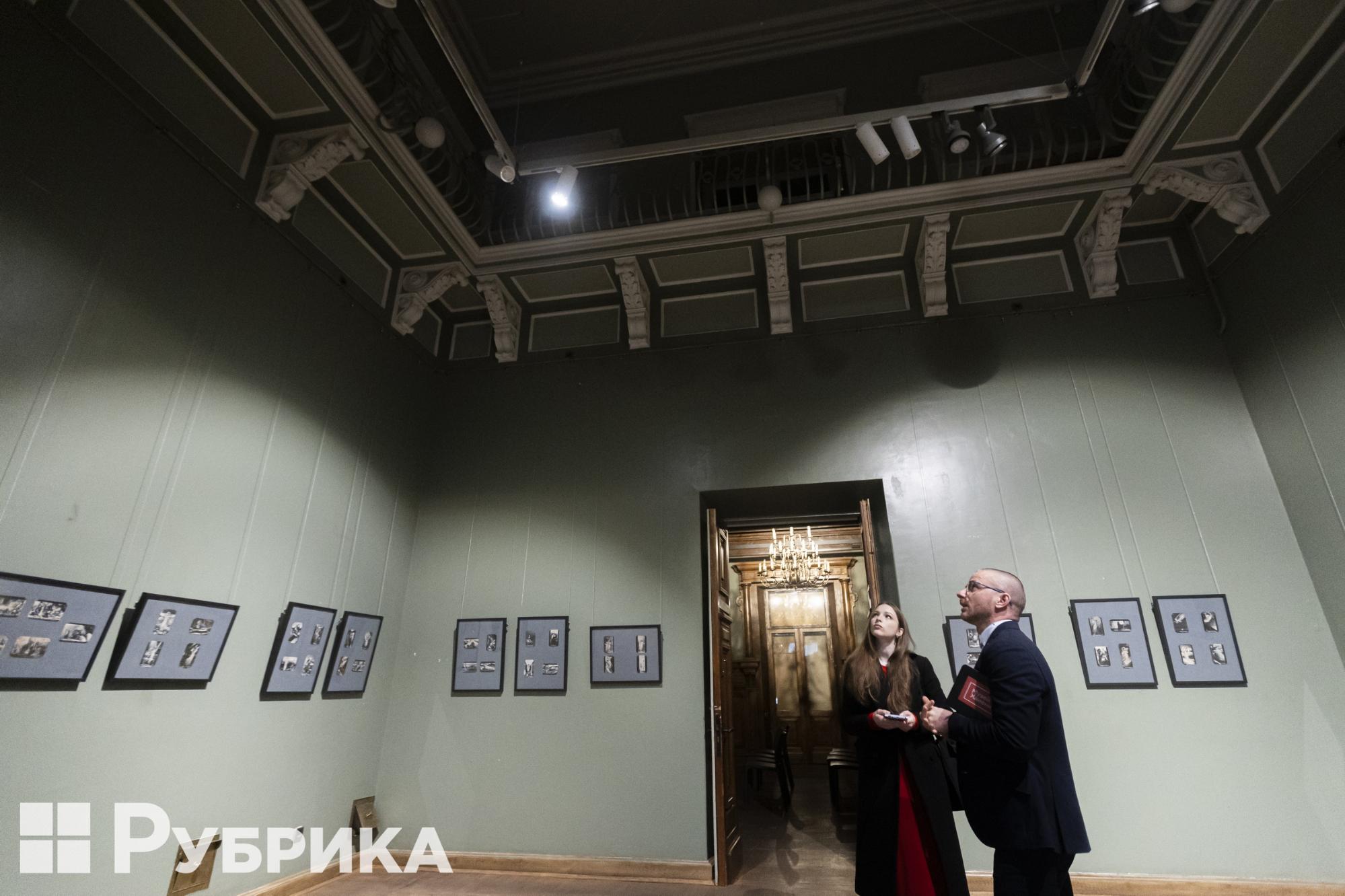
Oleksandr Zhuk talks about the gallery.
The hall is practically empty, so Zhuk's voice strongly echoes off the light blue walls. Before the full-scale invasion, they housed a collection of world art, and during our visit, they housed postage stamps. The room is illuminated only by special spotlights, although previously, the main light source was a window in the ceiling. But on October 10, 2022, it was destroyed by a Russian missile.
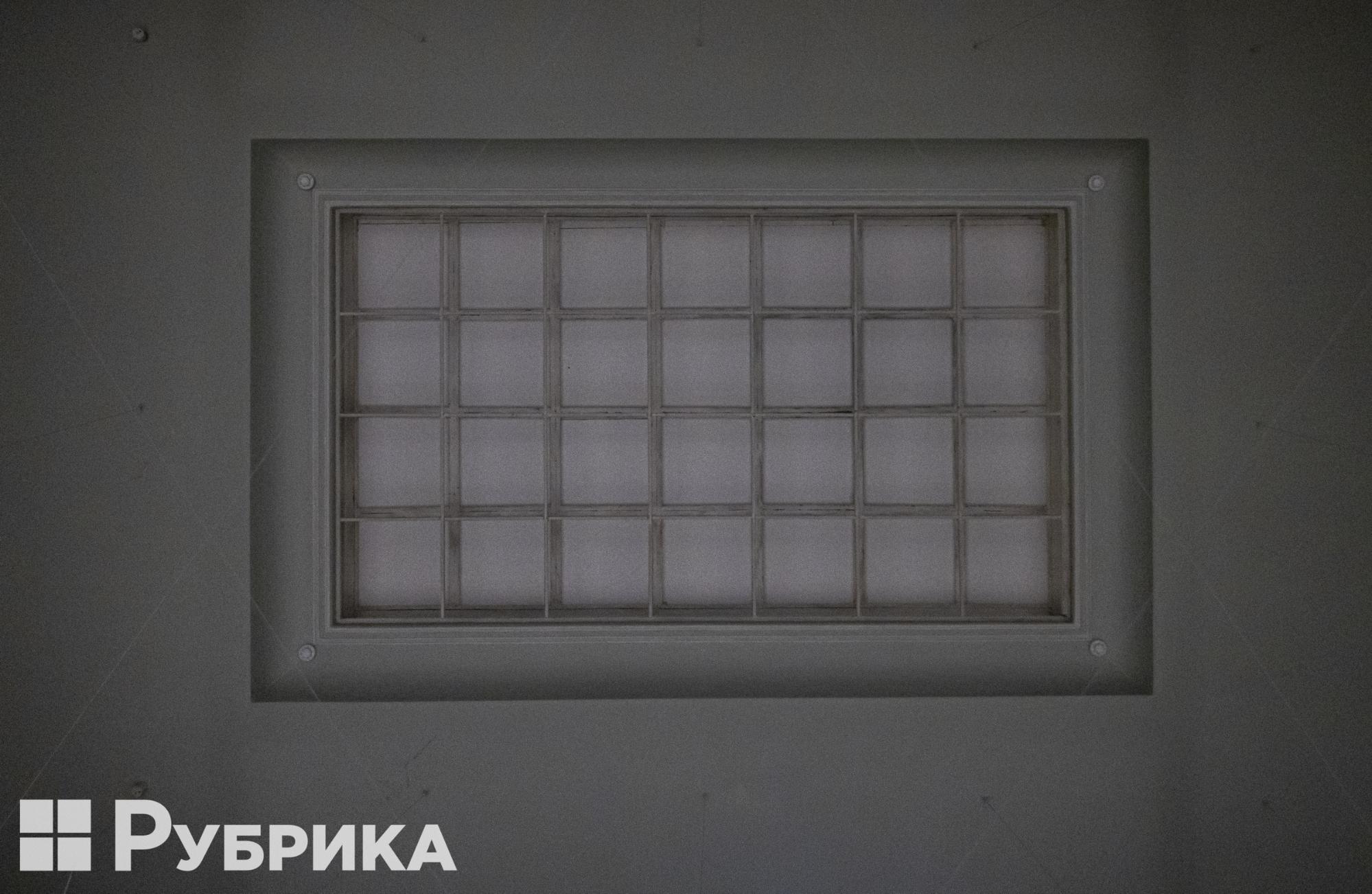
The skylight is cleared of broken glass and closed.
A part of the golden panel with cupids and flowers stands out among the postcards. It used to be on the ceiling of the Red Living Room, but it was dismantled on October 10, 2022. As part of the "Gold, Color, Light" project, every Thursday, employees demonstrated elements of the decoration of the Red Living Room.
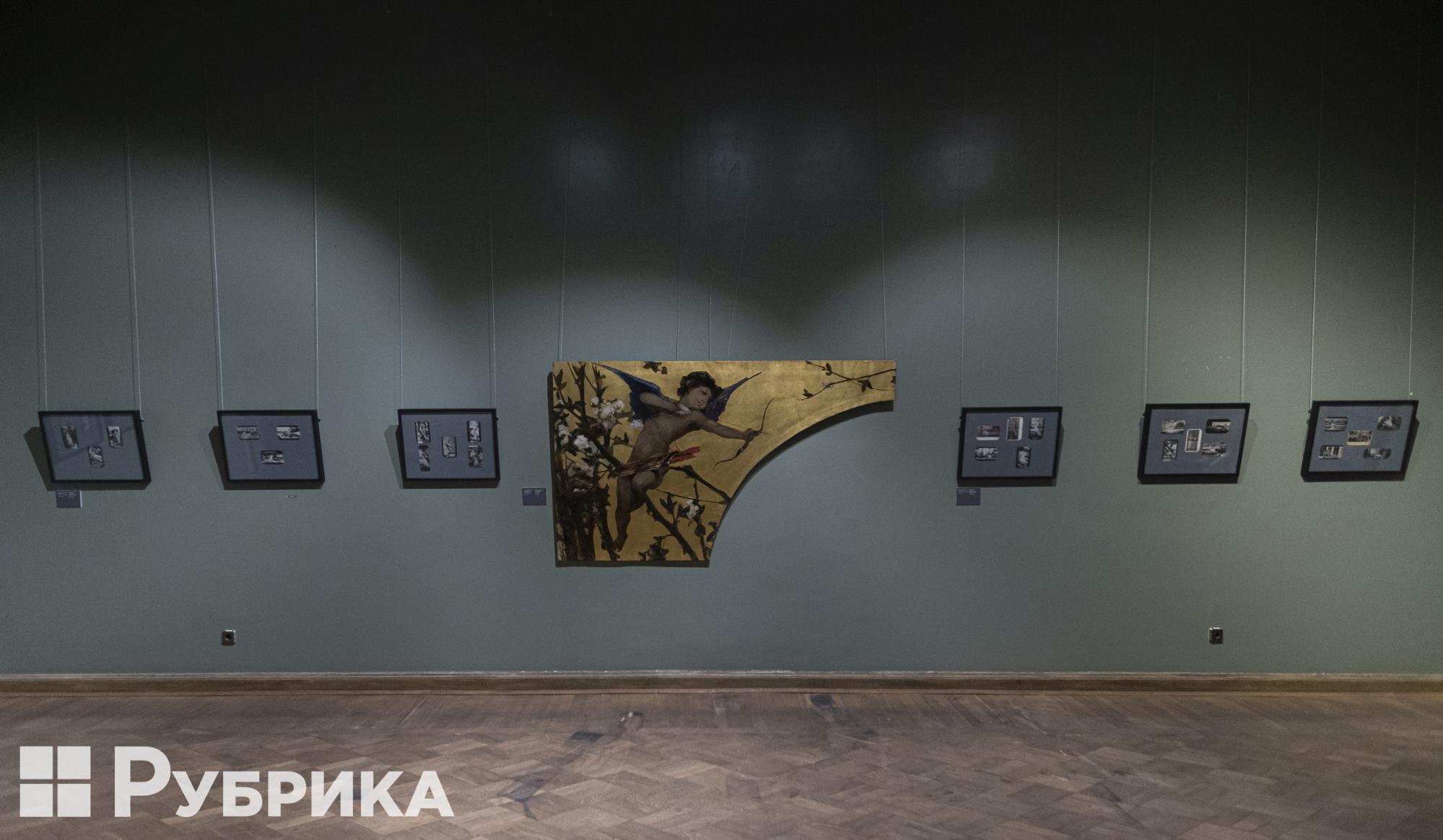
Part of the panel with cupids and flowers.
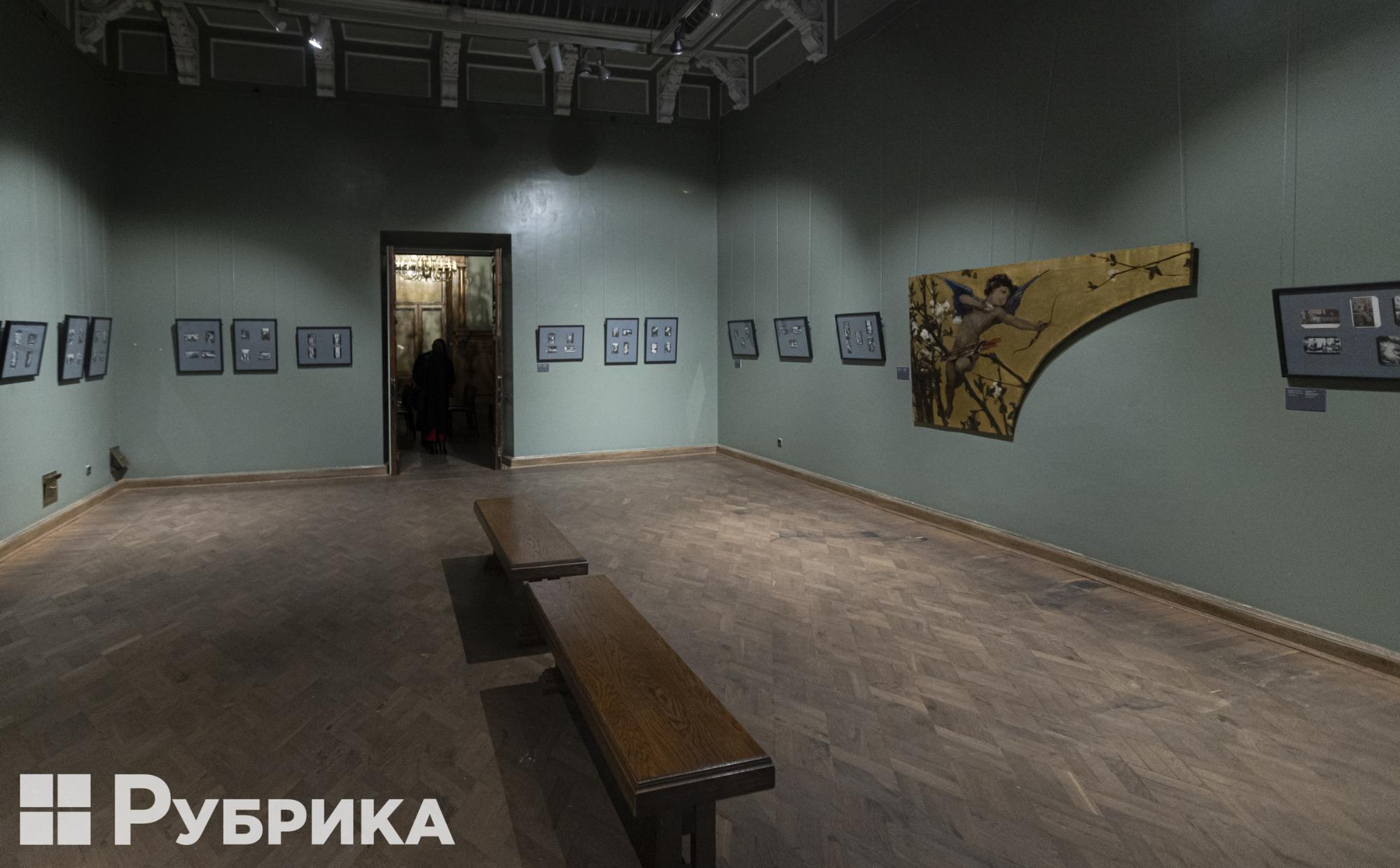
Wilhelm Kotarbinski made a panel in the style of Hans Makart.
Red Living Room
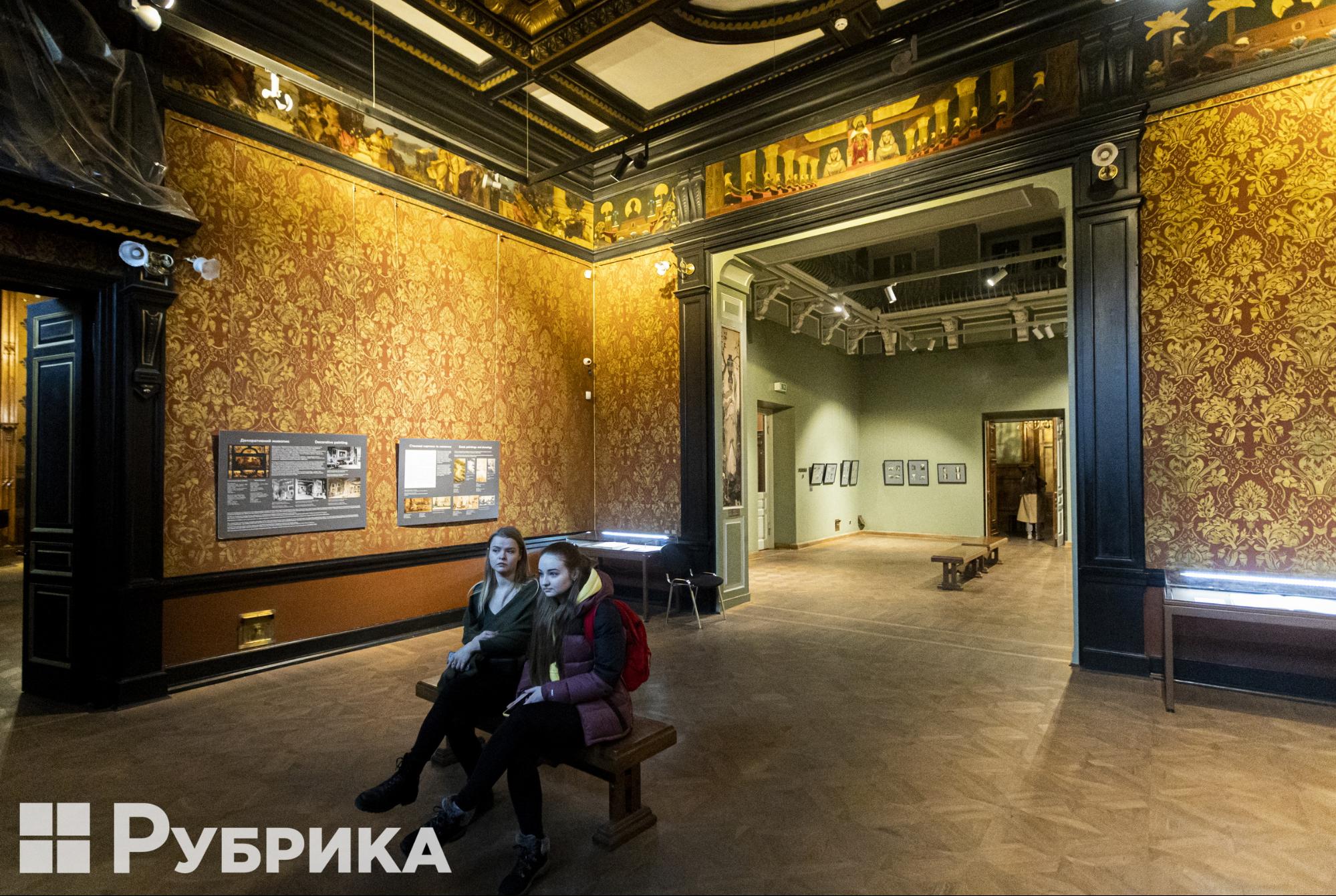
The Red Living Room of the Khanenko Museum.
The ceiling of this room was previously decorated with paintings by Kotarbinsky. It is divided by false beams. The artist Hans Makart painted the central panel, and Kotarbinski created panels around it, recreating Makart's style. He also painted friezes depicting ancient civilizations: India, Egypt, Rome, and Greece.
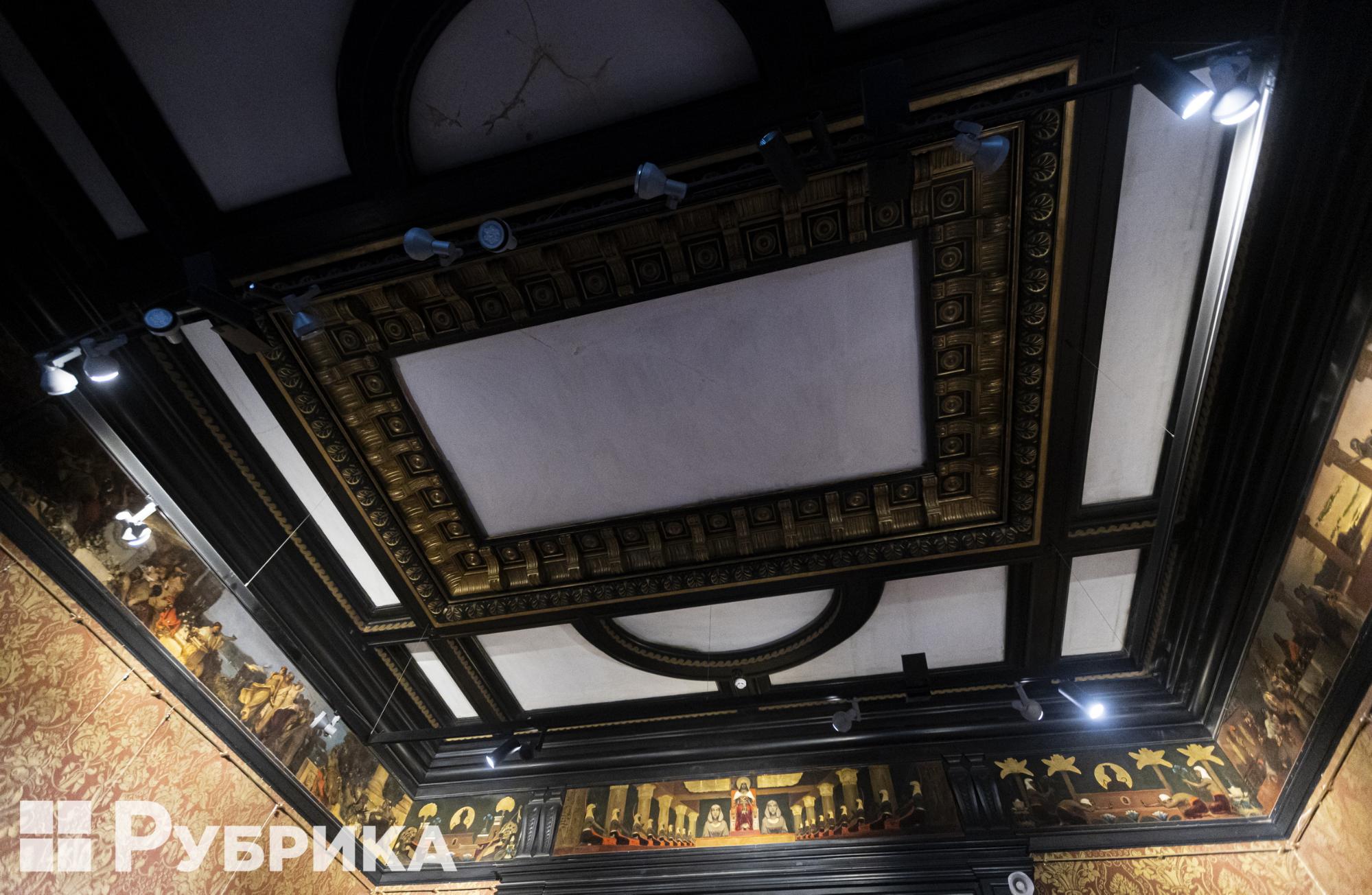
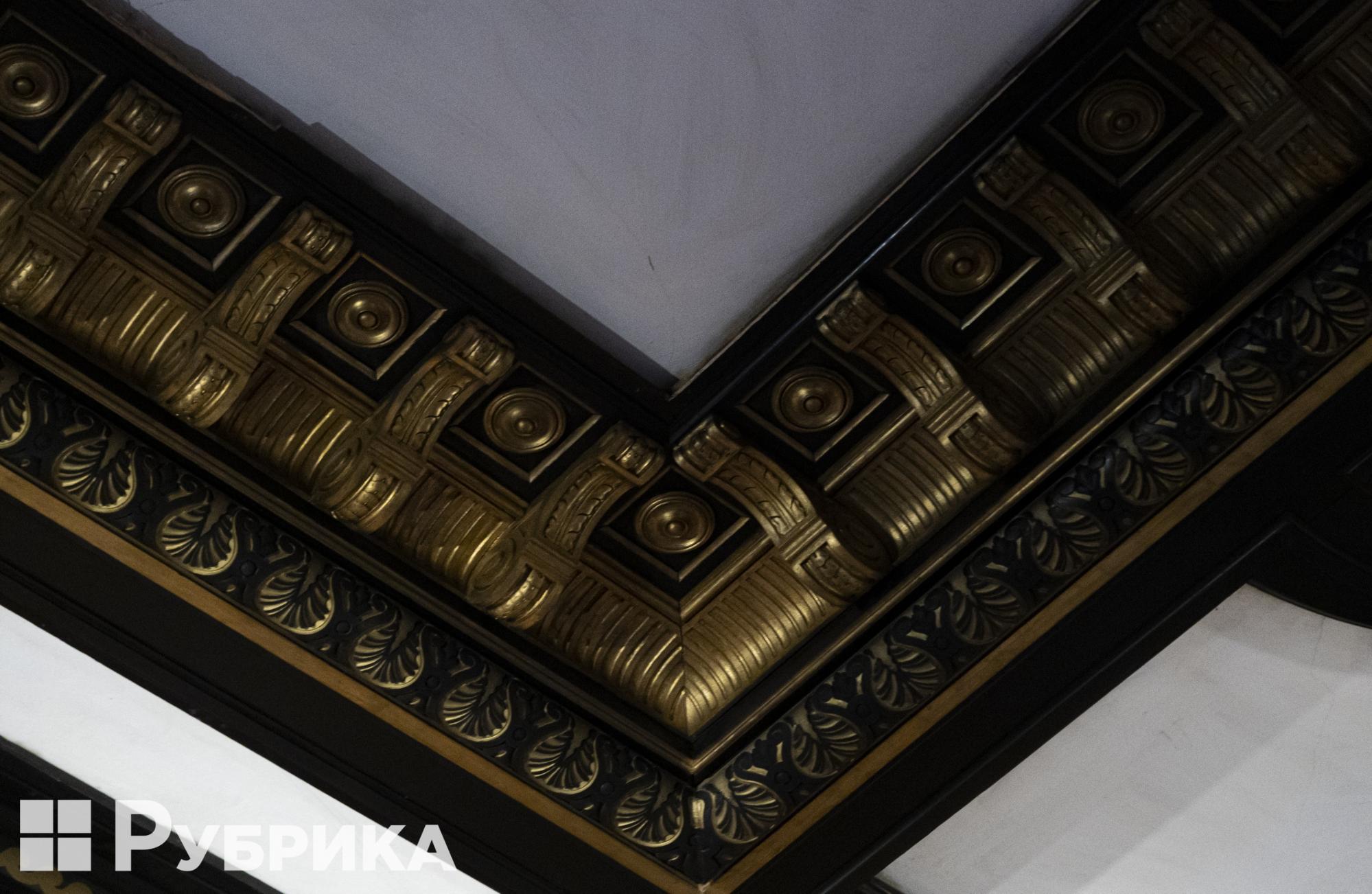
The empty ceiling of the Red Living Room after dismantling.
The windows are closed with shutters. Near them is a TV that plays classical music. The dark burgundy walls seem to absorb the melody — it is practically inaudible in the neighboring rooms. The screen shows the works of Kotarbinsky.
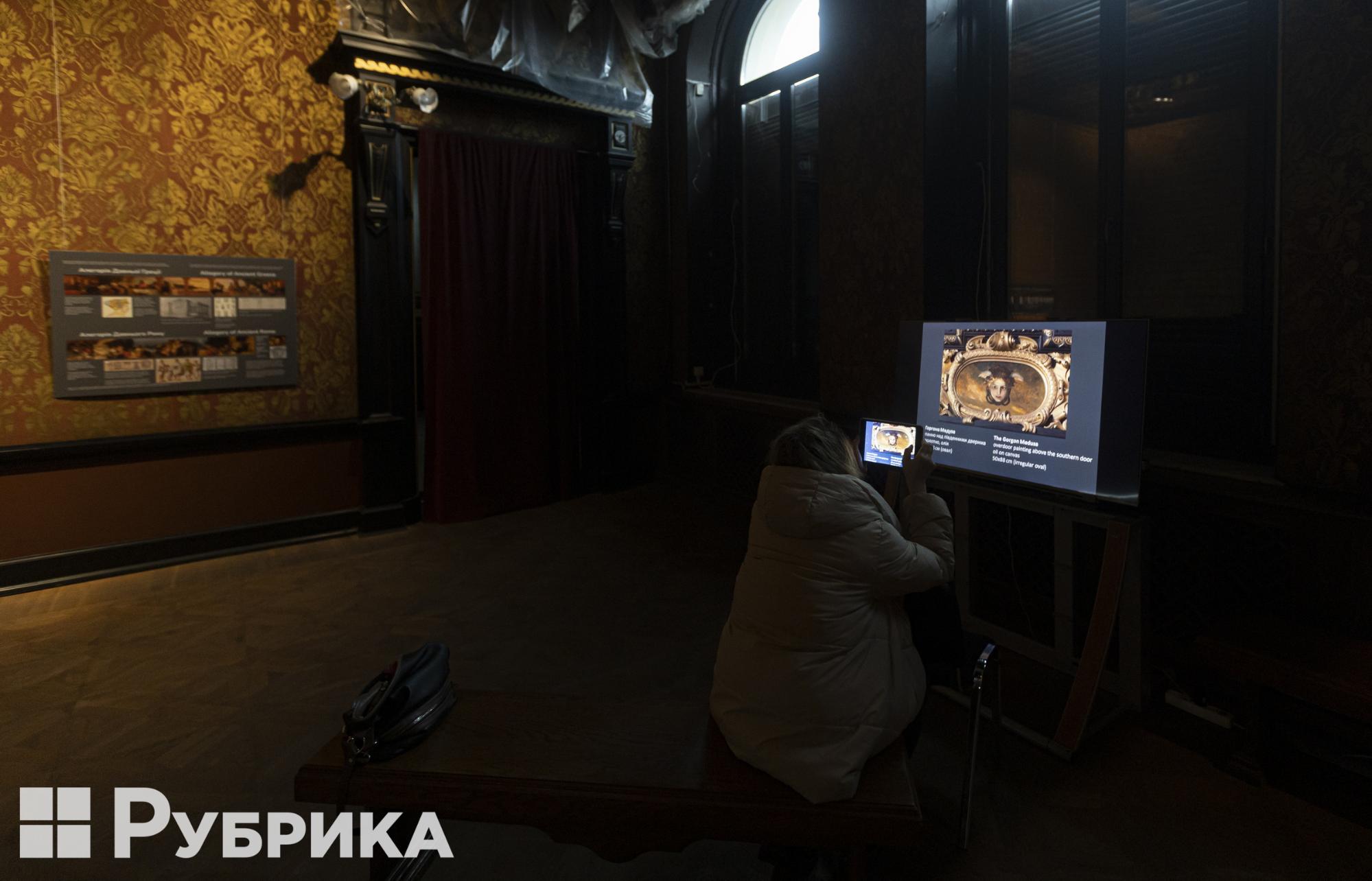
A visitor photographs slides with Kotarbinsky's works.
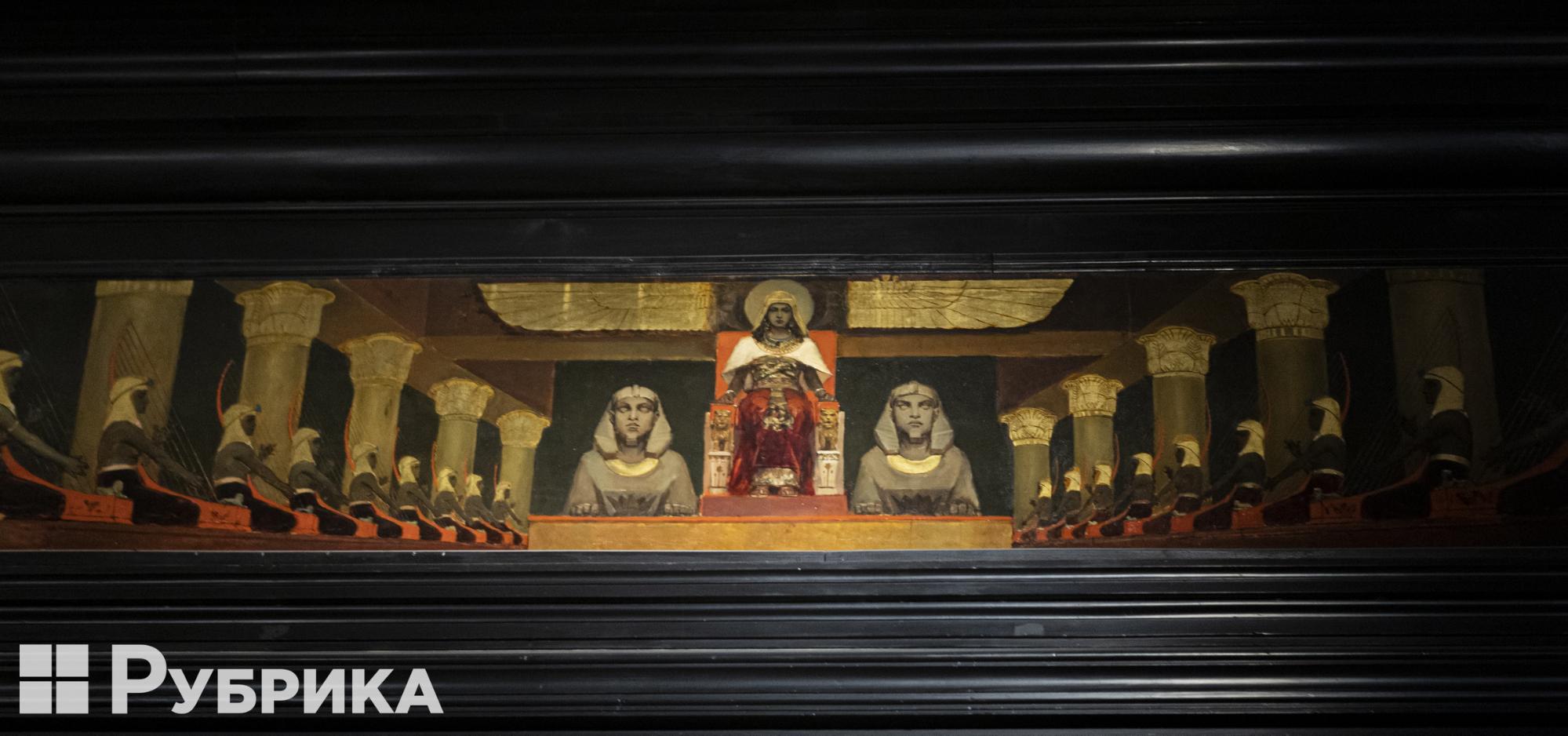
Allegory of Ancient Egypt.
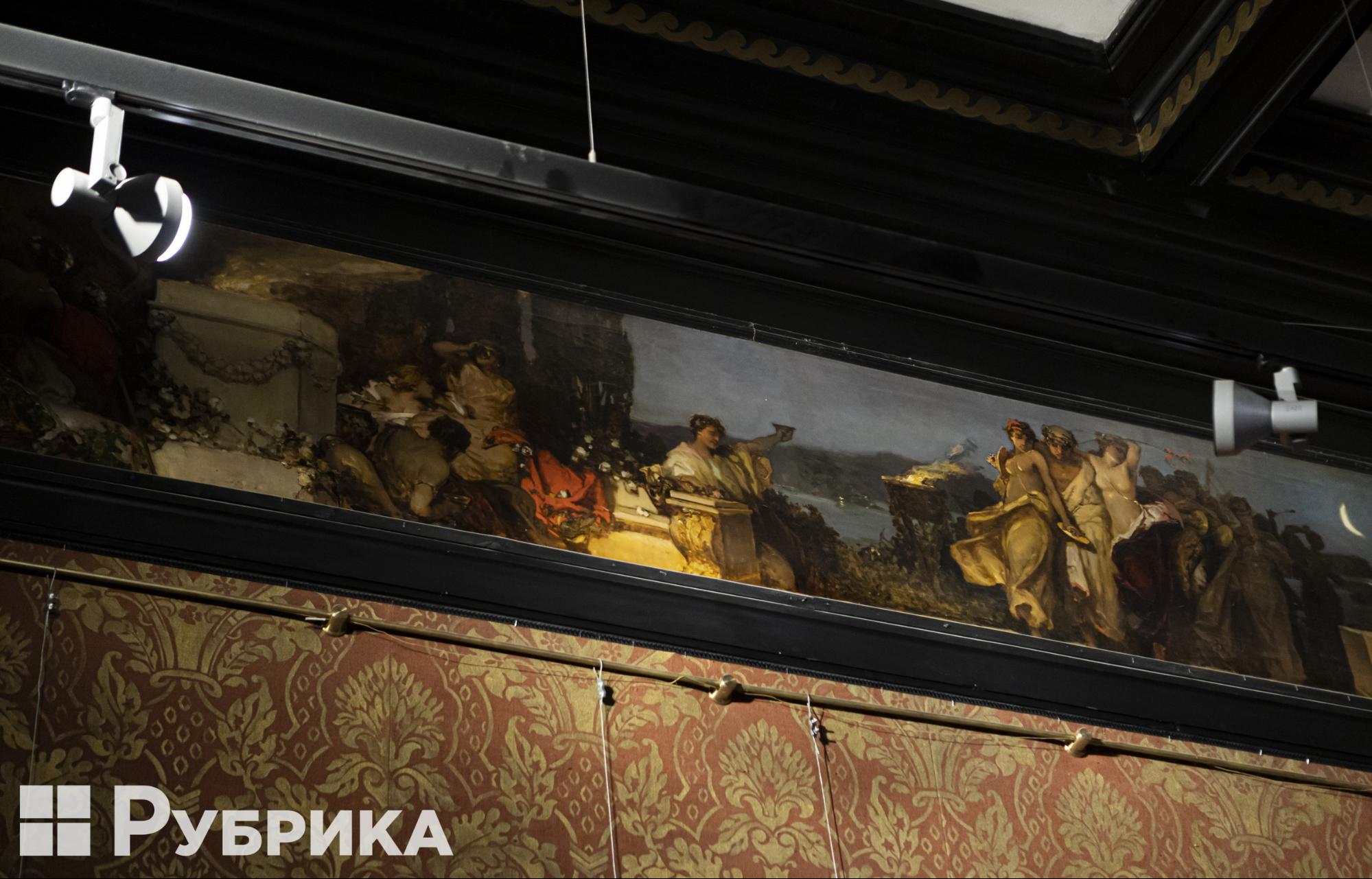
Allegory of Ancient Rome.
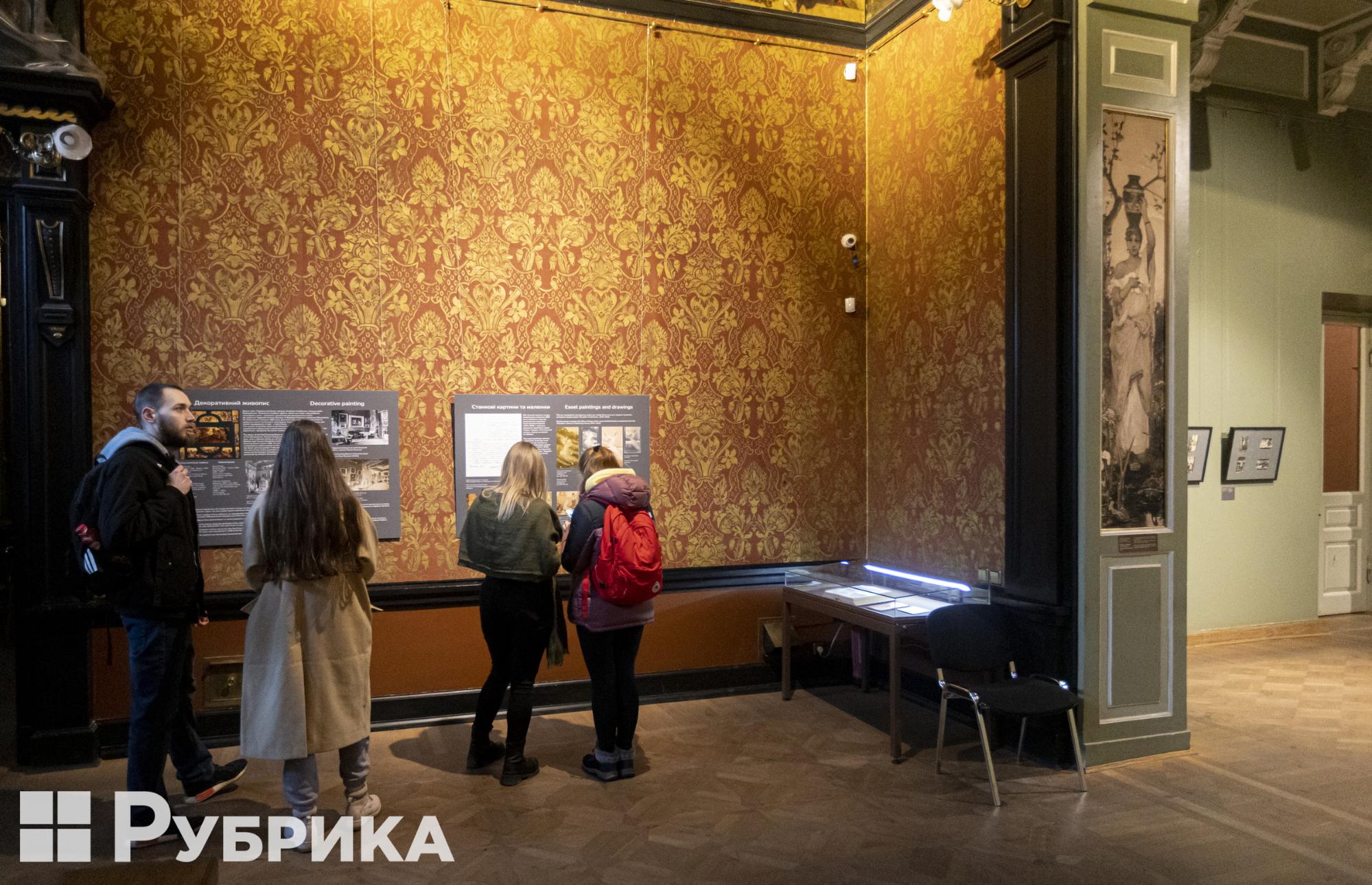
Visitors read about the decor of the Red Living Room.
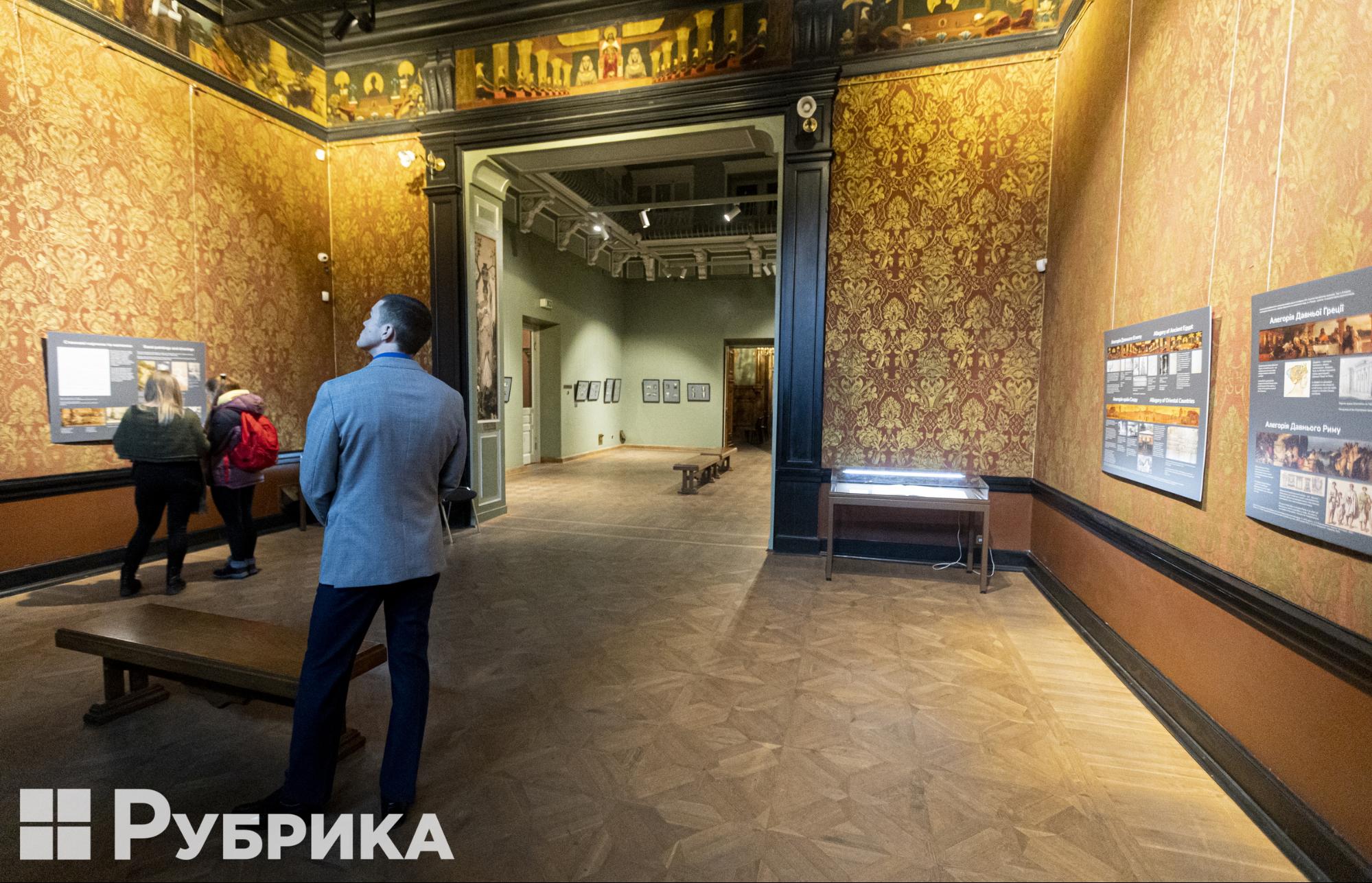
On the right are plates with a description of the friezes.
The large living room of the Khanenko manor
To the right of the Red Living Room is the main dining room of the Khanenko House. The hall looks like a knight's medieval palace because it is made with all the elements of the Gothic style: a wooden, flat ceiling without images is divided by false beams, and the decorative elements are pointed as if reaching for the sky. In the far part of the room is an imitation of a home chapel with a triptych as an iconostasis. During the life of the Khanenkos, it served as a decoration, and there were no services here. The main element of the hall is a high medieval fireplace.
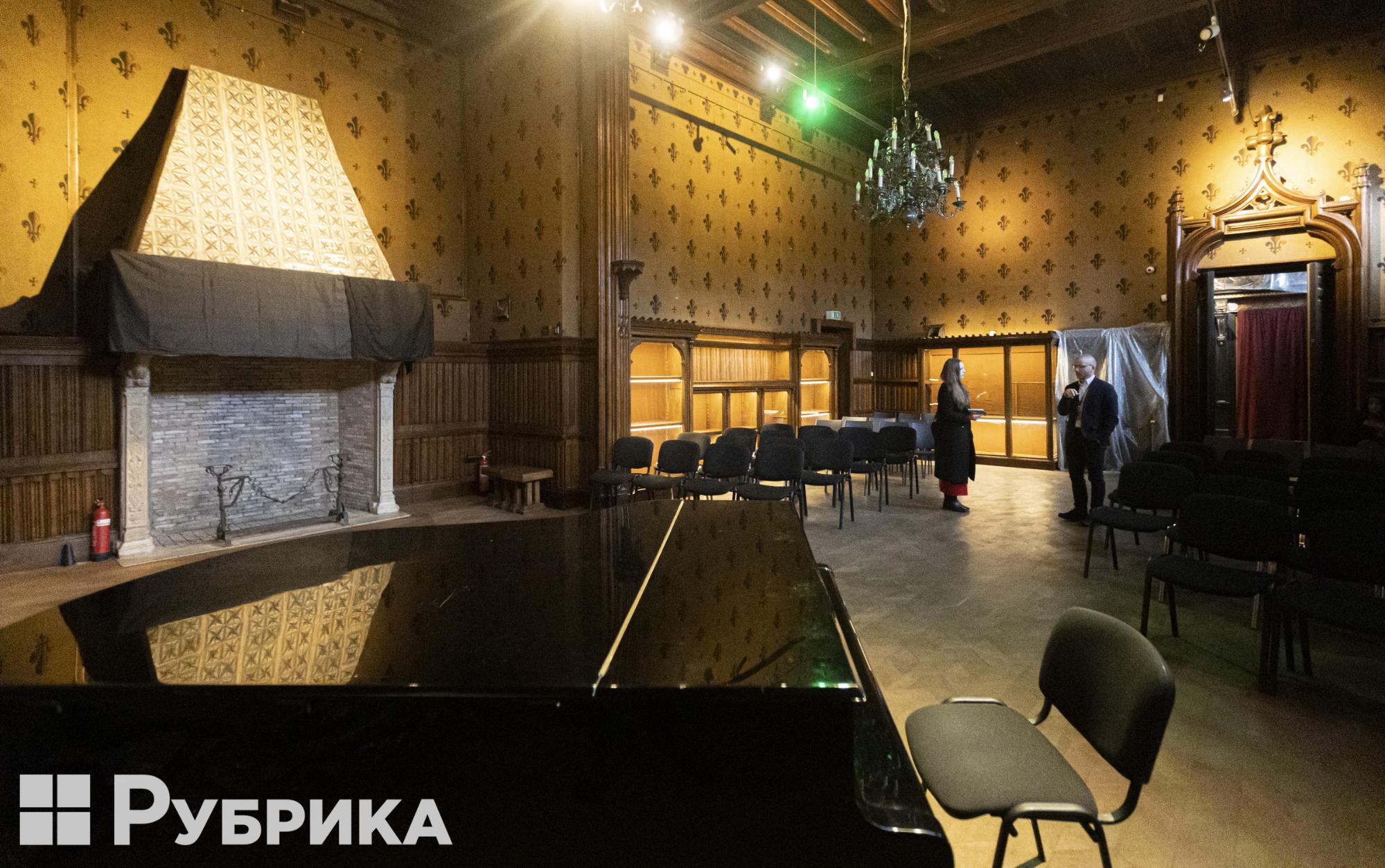
For the Khanenkos, the fireplace was more of a decoration than a heat source. The house was heated with hot air from the ventilation holes.
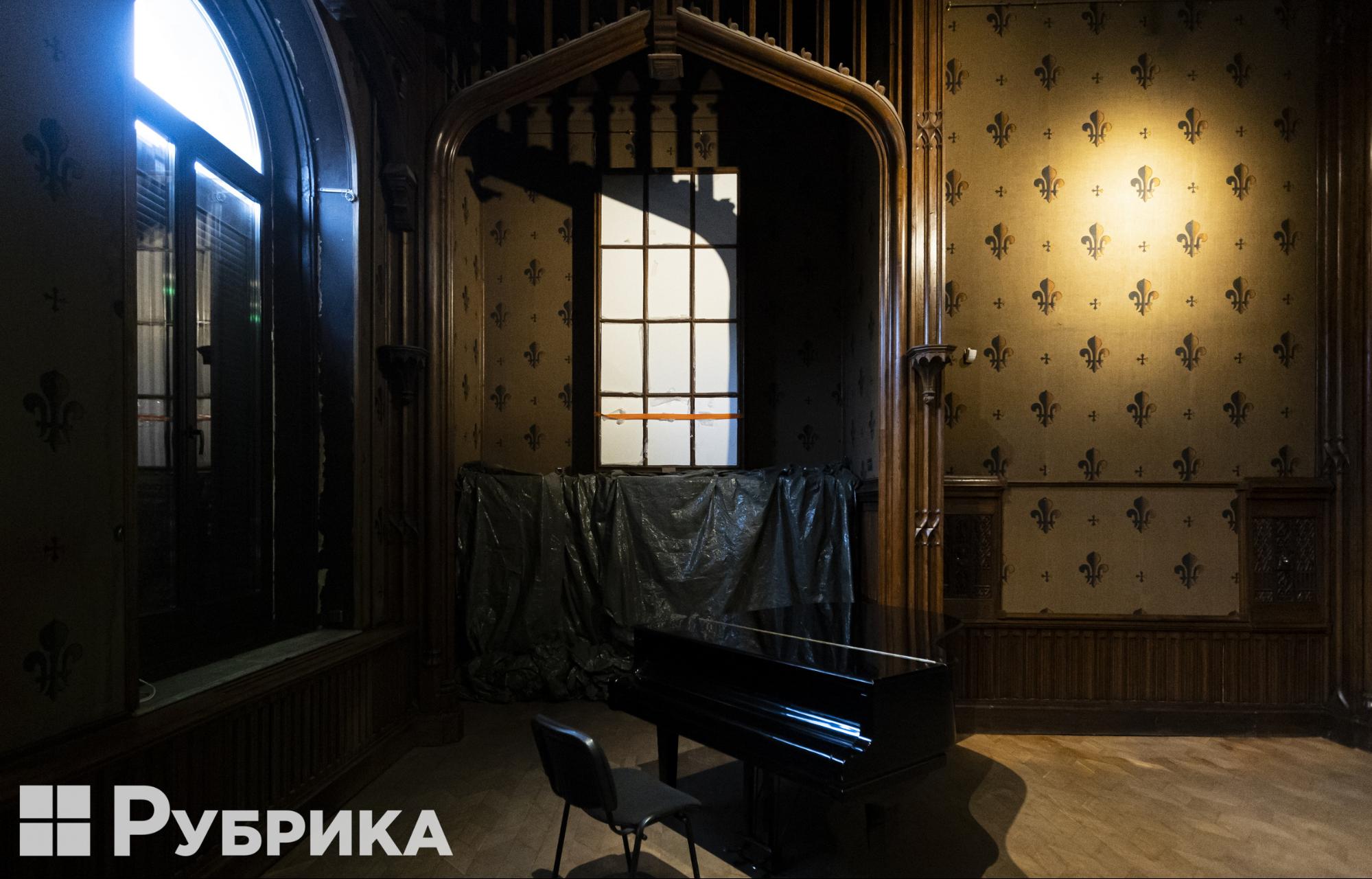
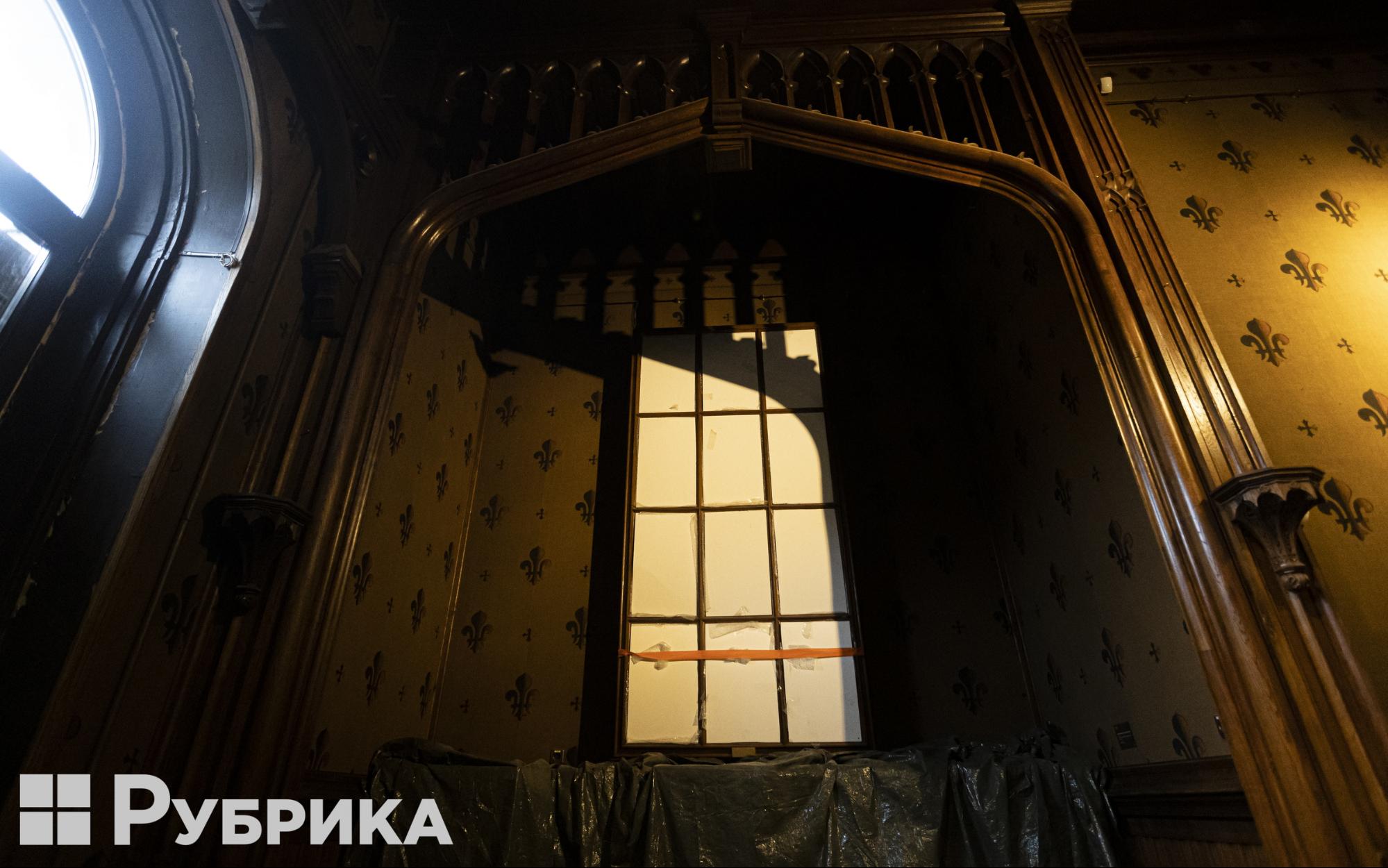
Home chapel, triptych dismantled and secured.
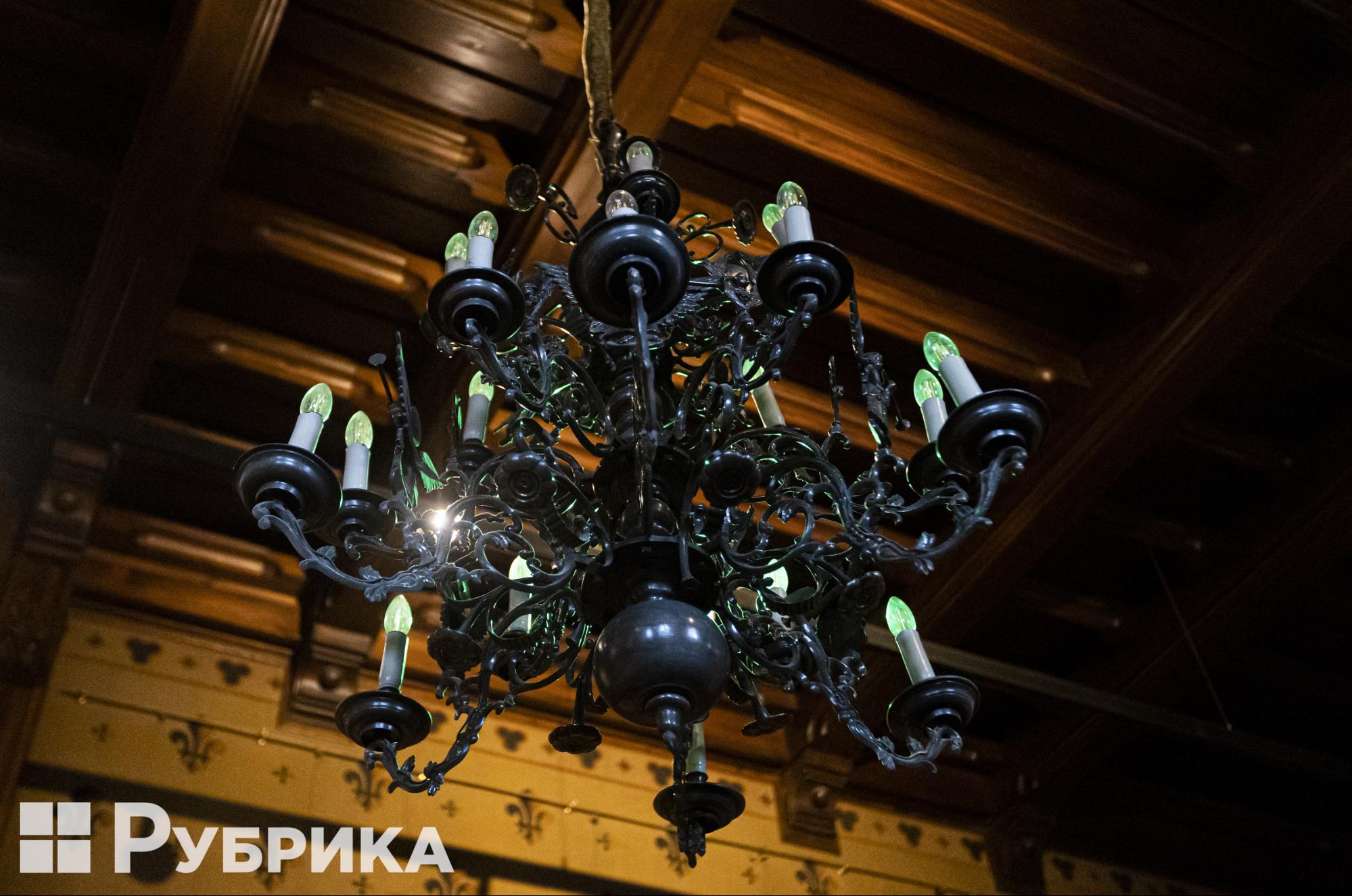
Gothic ceiling without painting.
Before the full-scale Russian invasion of Ukraine, icons of the VI-VII centuries could be seen in this hall. In June 2023, the museum transferred them to France for an exhibition at the Louvre, which lasted until November of the same year. The Byzantine heritage is being studied in the laboratory of the National Center for Research and Restoration of French Museums.
Golden Study or "Don Quixote" hall
To the left of the Red Living Room is the Rococo Golden Study. Tall mirrors visually expand a small room. The most exciting thing in the room is the painted ceiling. In the center of the composition is Don Quixote, who fights with windmills, and around it are family coats of arms. Only one of them is real, and all others are figments of the author's imagination. The artist depicted a palace with a star on a blue background, the ancestral coat of arms of the Khanenkos.
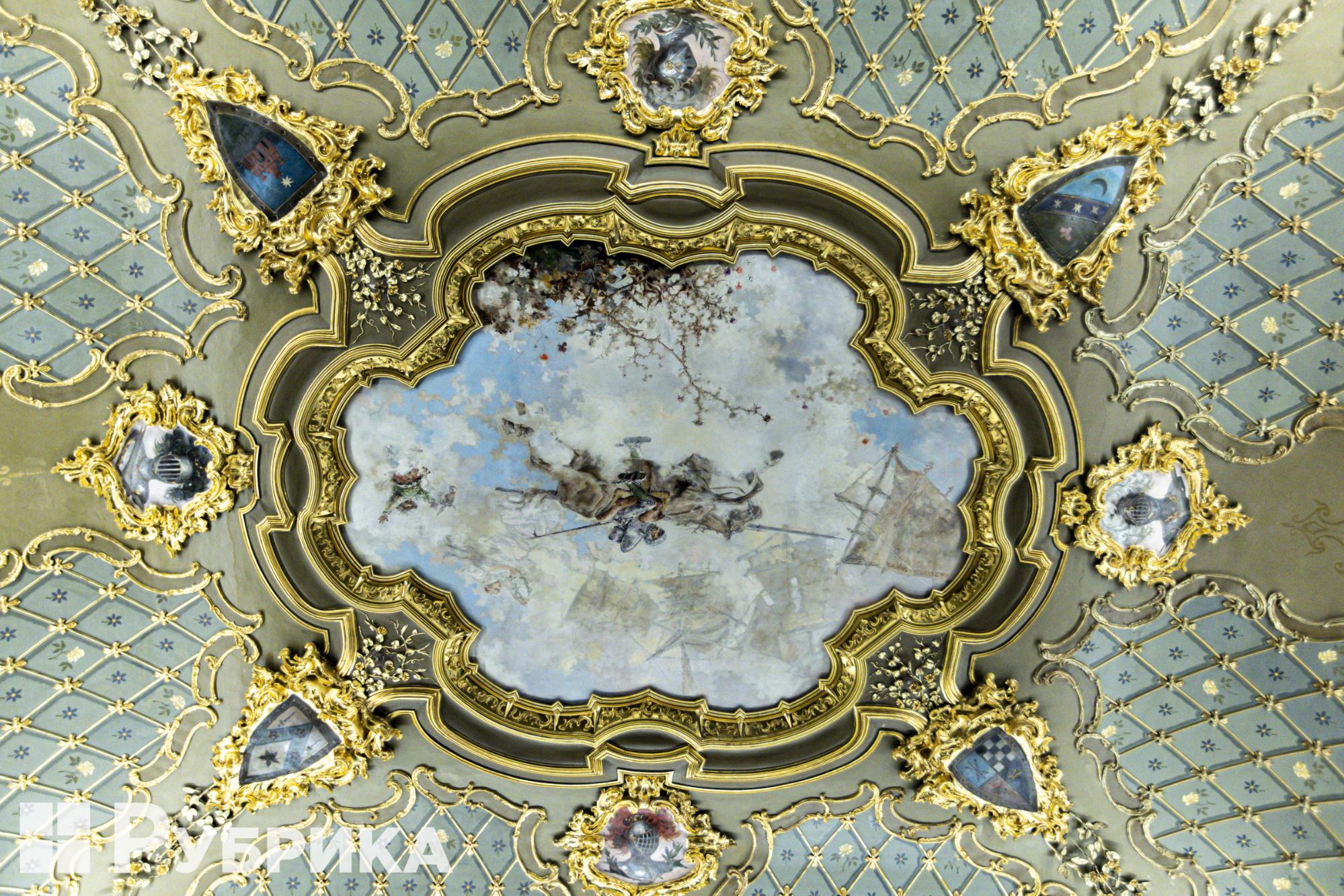
The painted ceiling of the Golden Study.
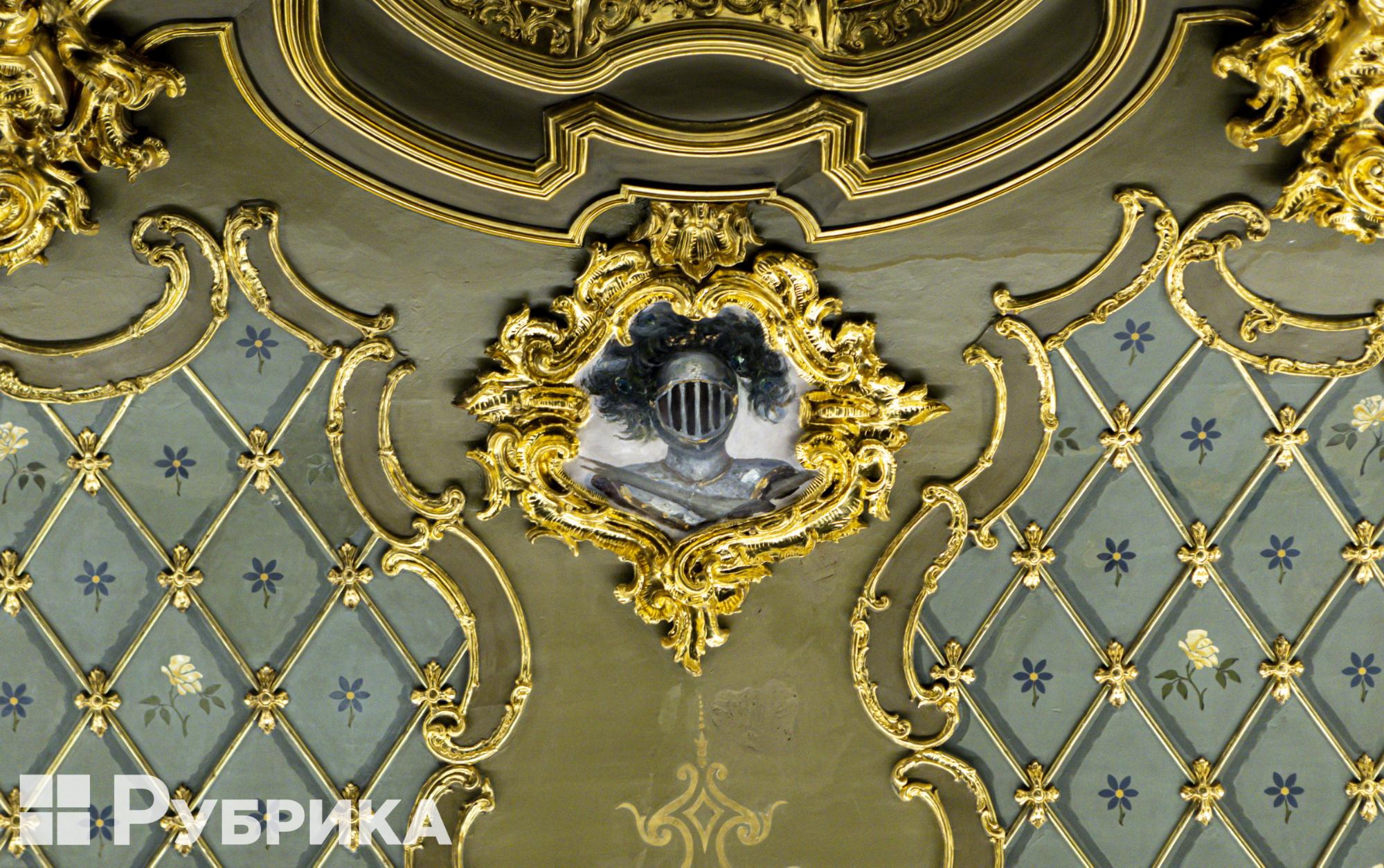
The ceiling is convex and decorated with gold trim.
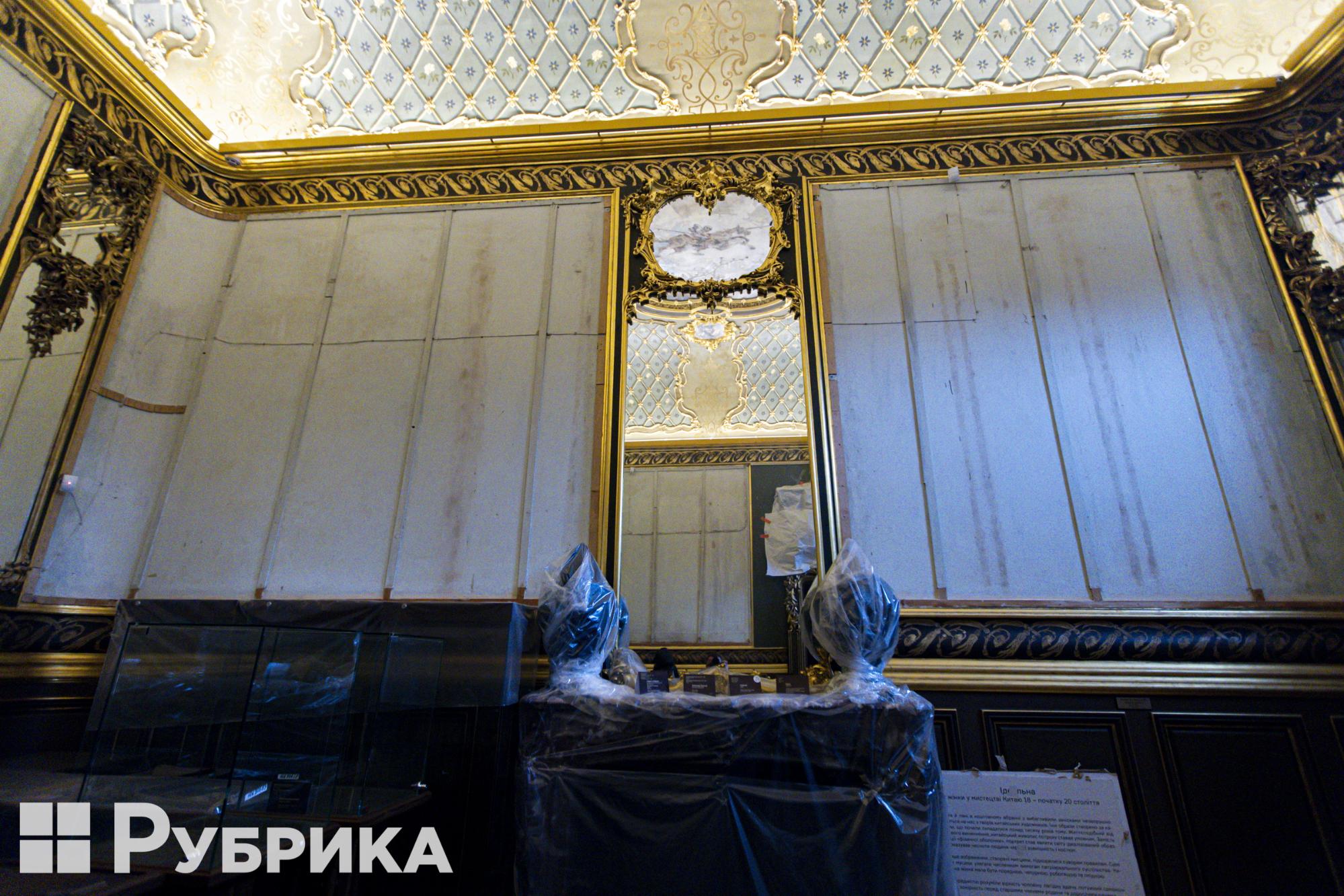
Large mirrors in the Golden Study.
The walls are empty now, but four Brussels carpets used to hang on them. They are often called tapestries, but as Zhuk explains, only products created at the Gobelen brothers' factory in the 14th century can be called that. The author of the carpets that the Khanenkos bought dedicated them to illustrations of Don Quixote and Sancho Panza, two for each.
The room is still under renovation. There are building materials and plywood sheets on the floor. Therefore, you can enter the hall only during a tour to look at the interior. At other times, visitors are not allowed there.
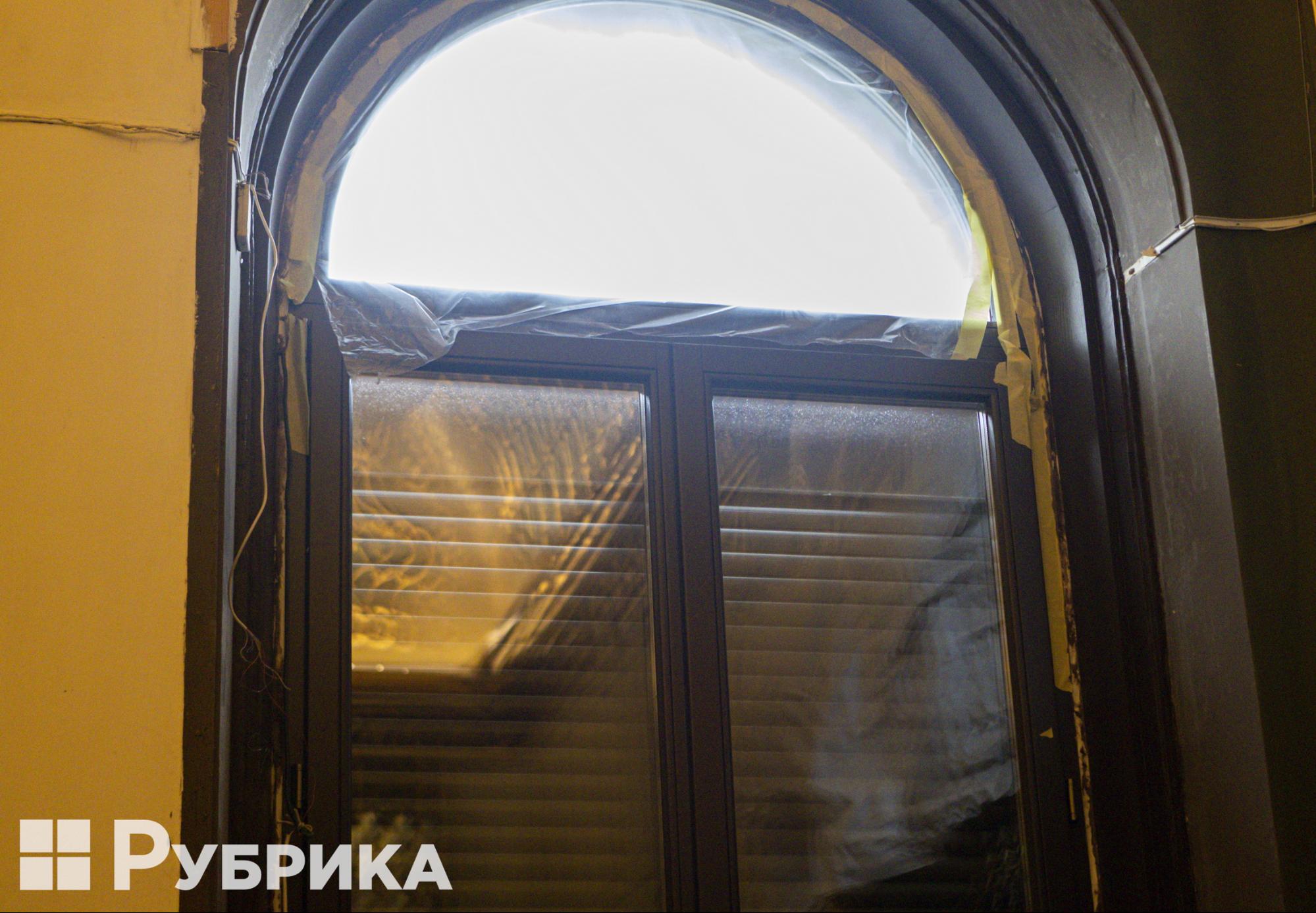
Windows during renovation.
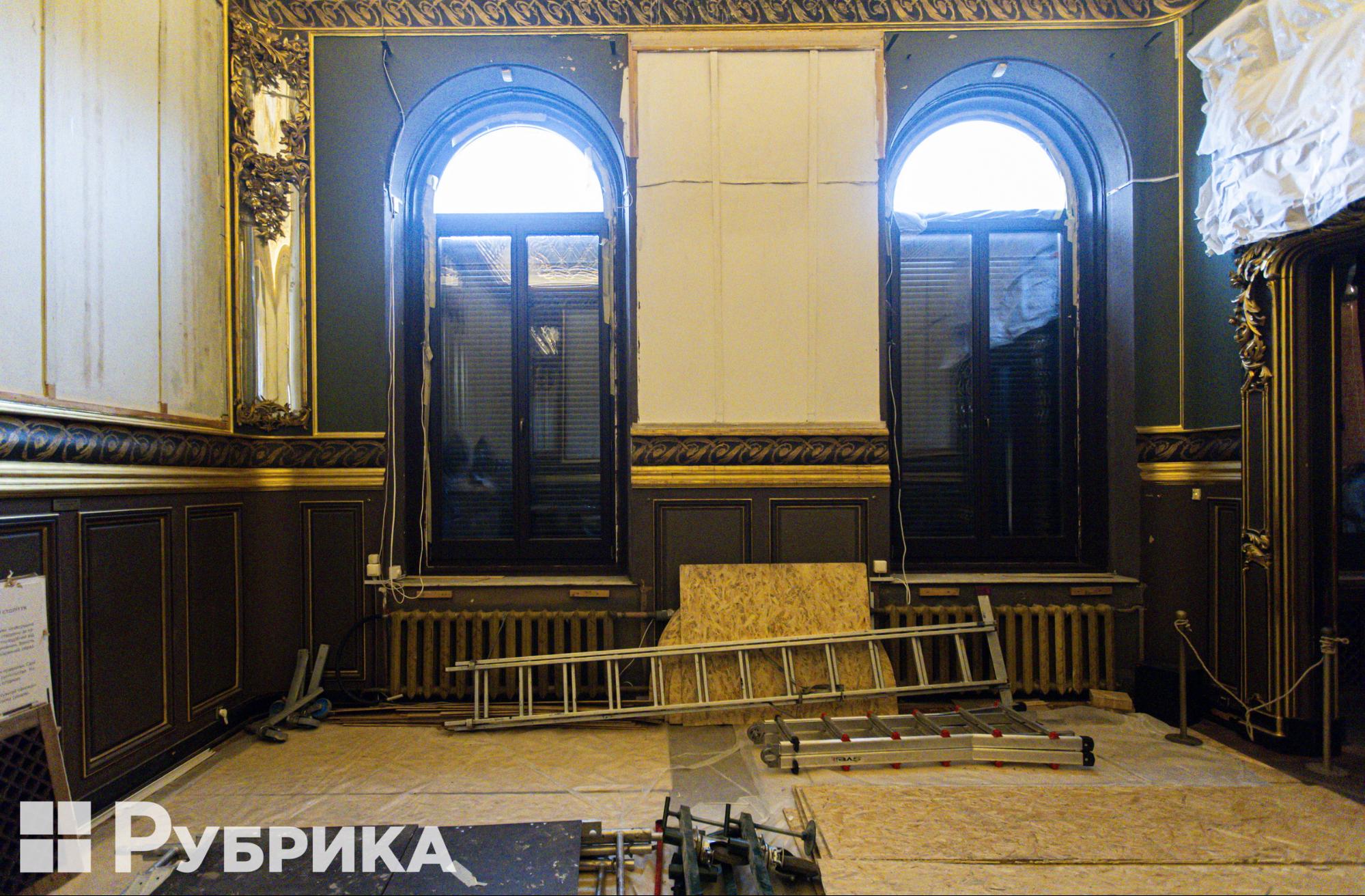
Building materials.
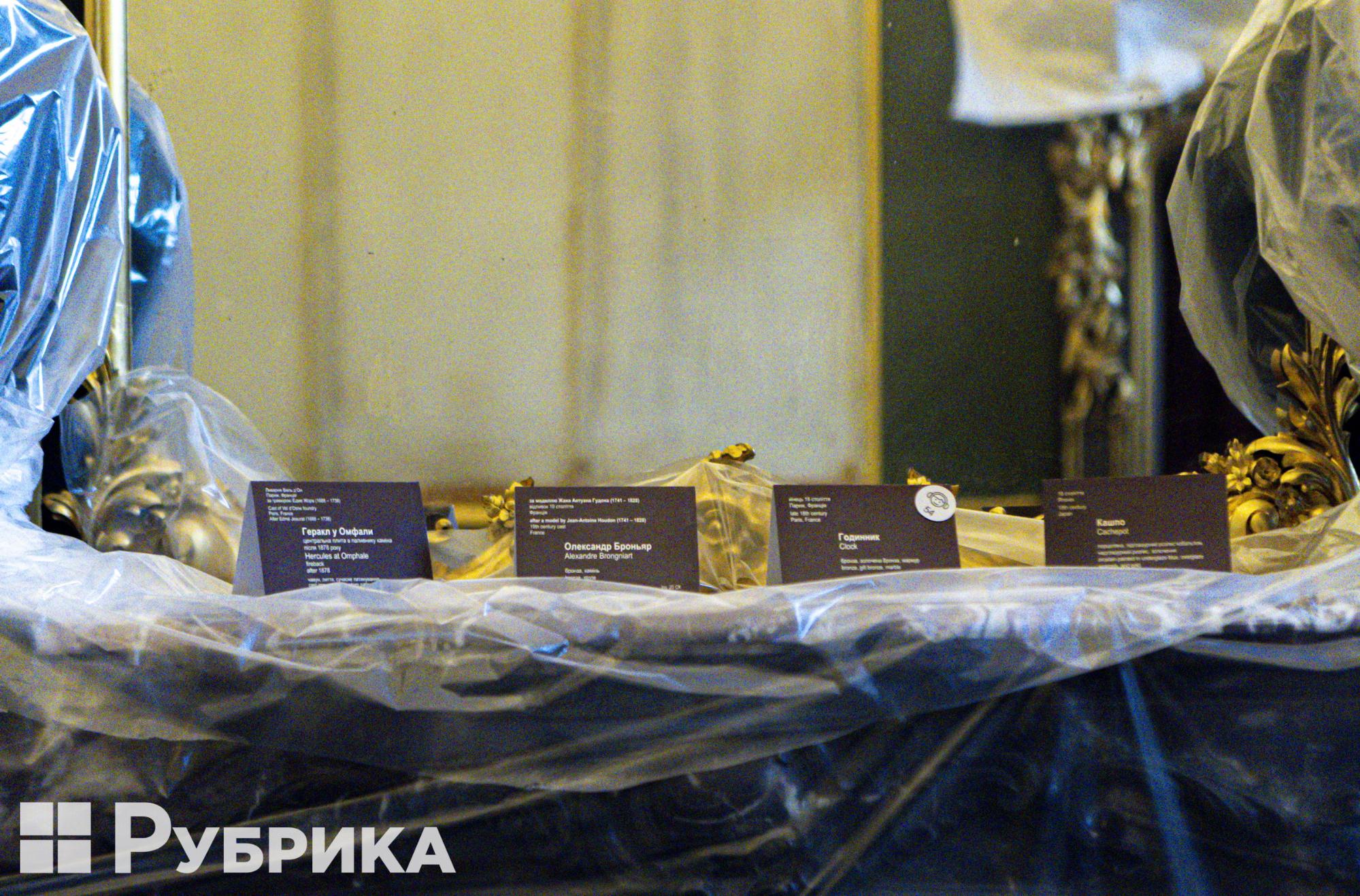
Plates for collection elements.
The museum was not closed to visitors despite renovation. Zhuk says that recently, there were journalists from Japan who asked why the museum was working during the war. Zhuk answered them: "Because we must." "The museum is in place, the interiors are in place, we are in sight — there is attention to us, and we have no right to neglect it," Zhuk shared with Rubryka.
The museum staff is looking forward to the moment when the security conditions will allow the Khanenko collection to be returned to the museum. But, as Zhuk notes, the museum will no longer work as it did until February 24, 2022.
"We do not have the right to simply arrange and hang everything as it was. In the current conditions, we reconsidered the concepts of "East" and "West" and thought about decolonization. Now, the Khanenko Museum team is saying it is necessary to move away from looking at Asian art through European perception. The Asian collection of the Khanenko Museum is the most valuable and largest in Ukraine. It will no longer be exhibited as before, divided into Islam, Buddhism, China, and Japan. It is necessary to rethink everything. This is a colossal job," explains Zhuk.
Newsletter
Digest of the most interesting news: just about the main thing



